Independent System Calibration of Sentinel-1B
Abstract
:1. Introduction
- StripMap (SM), with six different look angles (SM1–SM6), each beam covering a swath width of 80 km, spatial resolution 5 m × 5 m,
- Interferometric Wideswath (IW), illuminating a swath width of 250 km by switching between three different subswaths in elevation, spatial resolution 20 m × 5 m,
- Extra Wideswath (EW), covering the complete range of 400 km by switching between five different subswaths in elevation, spatial resolution 40 m × 20 m,
- Wave Mode (WV), by illuminating small vignettes (20 km × 20 km) within a distance of 100 km available for two different look angles, spatial resolution 5 m × 5 m.
2. In-Orbit Calibration Overview
- DLR’s novel C-band transponder, called “Kalibri”, was designed for the Sentinel-1 mission. Despite the compact design, as shown in Figure 2a, “Kalibri” provides a RCS of 60 dBm [7] at a center frequency of 5.405 GHz with a bandwidth of 100 MHz. As “Kalibri” serves as a radiometric reference, significant effort was spent on the radiometric calibration of these transponders. Different methods were analytically compared [8] and conducted in order to increase calibration confidence through cross-comparisons. Thus, a standard uncertainty of 0.2 dB has been achieved [9,10,11].
- DLR’s remote controlled trihedral corner reflector is shown in Figure 2b. This corner reflector is turned up-side down, allowing the opening facing downwards to be rotated when the corner reflector is not operated. This parking position reduces the accumulation of dirt over time and protects the opening from different weather conditions when the corner reflector is not being operated. With an inner leg length of 2.8 , the corner reflector provides a peak RCS of 49.2 dBm at the Sentinel-1 center frequency according to the physical optics approximation [12]. A similar standard uncertainty of 0.2 dB has been achieved by a low shape tolerance. Precise laser-tracker measurements have confirmed mechanical deviations (e.g., plate deformations) from an ideal corner shape, which result in RCS changes that are negligible at below ±1 mm.
3. Internal Calibration
3.1. Instrument Drift within Data Take
3.2. Time Delay
3.3. Instrument Stability
3.4. TRM Characterization
4. Geometric Calibration
4.1. The Pixel Localization Accuracy in Azimuth
4.2. The Pixel Localization Accuracy in Range
5. Antenna Pointing Determination
5.1. Antenna Pointing Determination in Azimuth
5.2. Antenna Pointing Determination in Elevation
6. In-Flight Antenna Model Verification
6.1. Verification in Azimuth
6.2. Verification in Elevation
7. Radiometric Calibration
7.1. Relative Radiometric Accuracy
7.2. Absolute Radiometric Calibration
8. Polarimetric Characterization
8.1. Channel Imbalance
- the delivered standard product which includes a common correction by the antenna pattern (solid lines), and
- rainforest data without the correction of the antenna pattern (dotted lines).
8.2. Cross-Talk
9. Interferometric Verification
- Burst mis-synchronization, i.e., the ability to start interferometric acquisitions at orbital positions with the same argument of latitude, thus observing targets on the ground under the same Doppler centroid.
- Mean Doppler centroid frequency, related to the attitude stability of the satellite for different passes.
- Resulting common Doppler bandwidth, coming from the combination of the two previous points.
- Baseline in the zero Doppler plane, in order to check whether the satellite is kept within the orbital tube and also relevant in terms of common bandwidth range.
- Residual azimuth coregistration error consistency (using SAR Data) for the exploitation of the azimuth shifts for accurate coregistration or geophysical measurements.
9.1. Repeat-Pass Interferometric Consistency Evaluation
9.2. Interferometric Verification of Long Data Takes
10. Radiometric Cross-Check between Sentinel-1A and Sentinel-1B
11. Conclusions
Acknowledgments
Author Contributions
Conflicts of Interest
References
- Geudtner, D.; Potin, P.; Torres, R.; Snoeij, P.; Bibby, D. Overview of the GMES Sentinel-1 Mission. In Proceedings of the 9th European Conference on Synthetic Aperture Radar, Nuremberg, Germany, 23–26 April 2012; pp. 159–161. [Google Scholar]
- Zan, F.D.; Guarnieri, A.M. TOPSAR: Terrain Observation by Progressive Scans. IEEE Trans. Geosci. Remote Sens. 2006, 44, 2352–2360. [Google Scholar] [CrossRef]
- Schwerdt, M.; Schmidt, K.; Tous Ramon, N.; Castellanos Alfonzo, G.; Döring, B.; Zink, M.; Prats, P. Independent Verification of the Sentinel-1A System Calibration. IEEE J. Sel. Top. Appl. Earth Obs. Remote Sens. 2016, 9, 994–1007. [Google Scholar] [CrossRef]
- Schwerdt, M.; Bräutigam, B.; Döring, B.; Zink, M. A first Assessment of an Strategy of Sentinel-1 Calibration. In Proceedings of the CEOS SAR Calibration and Validation Workshop, Oberpfaffenhofen, Germany, 27–28 November 2008. [Google Scholar]
- Schwerdt, M.; Döring, B.; Zink, M.; Schrank, D. In-Orbit Calibration Plan of Sentinel-1. In Proceedings of the 8th European Conference on Synthetic Aperture Radar, Aachen, Germany, 7–10 June 2010. [Google Scholar]
- Reimann, J.; Schwerdt, M.; Schmidt, K.; Tous Ramon, N.; Döring, B. The DLR Spaceborne SAR System Calibration Center. Frequenz 2017. [Google Scholar] [CrossRef]
- Jirousek, M.; Döring, B.; Rudolf, D.; Raab, S.; Schwerdt, M. Development of the Highly Accurate DLR “Kalibri” Transponder. In Proceedings of the 10th European Conference on Synthetic Aperture Radar, Berlin, Germany, 3–5 June 2014. [Google Scholar]
- Raab, S.; Döring, B.; Jirousek, M.; Reimann, J.; Rudolf, D.; Schwerdt, M. Comparison of Absolute Radiometric Transponder Calibration Strategies. In Proceedings of the 10th European Conference on Synthetic Aperture Radar, Berlin, Germany, 3–5 June 2014. [Google Scholar]
- Rudolf, D.; Döring, B.; Jirousek, M.; Raab, S.; Reimann, J.; Schwerdt, M. Absolute Radiometric Calibration of C-Band Transponders with Proven Plausibility. In Proceedings of the 10th European Conference on Synthetic Aperture Radar, Berlin, Germany, 3–5 June 2014. [Google Scholar]
- Döring, B.J.; Jirousek, M.; Rudolf, D.; Raab, S.; Reimann, J.; Schwerdt, M. The Three-Transponder Method: A Novel Method for Accurate Transponder RCS Calibration. Prog. Electromagn. Res. B 2014, 61, 297–315. [Google Scholar] [CrossRef]
- Döring, B.J.; Schmidt, K.; Jirousek, M.; Daniel, R.; Reimann, J.; Raab, S.; John, A.; Schwerdt, M. Hierarchical Bayesian Data Analysis in Radiometric SAR System Calibration: A Case Study on Transponder Calibration with RADARSAT-2 Data. Remote Sens. 2013, 5, 6667–6690. [Google Scholar] [CrossRef]
- Knott, E.F.; Shaeffer, J.F.; Tuley, M.T. Radar Cross Section, 2nd ed.; SciTech Publishing: Raleigh, NC, USA, 2004. [Google Scholar]
- Hounam, D.; Schwerdt, M.; Zink, M. Active Antenna Module Characterisation by Pseudo-Noise Gating. In Proceedings of the 25th ESA Antenna Workshop on Satellite Antenna Technology, Noordwijk, The Netherlands, 18–20 September 2002. [Google Scholar]
- Tous Ramon, N.; Schwerdt, M.; Castellanos Alfonzo, G.; Schmidt, K. Verification of Sentinel-1B Internal Calibration—First Results. In Proceedings of the 11th European Conference on Synthetic Aperture Radar, Hamburg, Germany, 6–9 June 2016. [Google Scholar]
- Bräutigam, B.; Schwerdt, M.; Bachmann, M. An Efficient Method for Performance Monitoring of Active Phased Array Antennas. IEEE Trans. Geosci. Remote Sens. 2009, 47, 1236–1243. [Google Scholar] [CrossRef]
- Schubert, A.; Small, D.; Miranda, N.; Geudtner, D.; Meier, E. Sentinel-1A Product Geolocation Accuracy: Commissioning Phase Results. Remote Sens. 2015, 7, 9431–9449. [Google Scholar] [CrossRef]
- Schwerdt, M.; Bräutigam, B.; Bachmann, M.; Döring, B.; Schrank, D.; Gonzalez, J.H. Final TerraSAR-X Calibration Results Based on Novel Efficient Calibration Methods. IEEE Trans. Geosci. Remote Sens. 2010, 48, 677–689. [Google Scholar] [CrossRef]
- Schwerdt, M.; Gonzalez, J.H.; Bachmann, M.; Schrank, D.; Döring, B.; Ramon, N.T.; Antony, J.W. In-Orbit Calibration of the TanDEM-X System. In Proceedings of the 2011 IEEE International Geoscience and Remote Sensing Symposium, Vancouver, BC, Canada, 24–29 July 2011. [Google Scholar]
- Bachmann, M.; Schwerdt, M.; Bräutigam, B. Accurate Antenna Pattern Modeling for Phased Array Antennas in SAR Applications—Demonstration on TerraSAR-X. Int. J. Antennas Propag. 2009. [Google Scholar] [CrossRef]
- Schied, E. Instrument Calibration and Performance Analysis & Budget; S1-RP-ASD-PL-0003 Issue 6.1; Astrium GmbH an EADS Company: Paris, France, 2013. [Google Scholar]
- Prats-Iraola, P.; Rodriguez-Cassola, M.; Lopez-Dekker, P.; Scheiber, R.; De Zan, F.; Barat, I.; Geudtner, D. Considerations of the Orbital Tube for Interferometric Applications. In Proceedings of the ESA FRINGE Workshop, Frascati, Italy, 23–27 March 2015. [Google Scholar]
- Prats-Iraola, P.; Scheiber, R.; Marotti, L.; Wollstadt, S.; Reigber, A. TOPS Interferometry With TerraSAR-X. IEEE Trans. Geosci. Remote Sens. 2012, 50, 3179–3188. [Google Scholar] [CrossRef]
- Yague-Martinez, N.; Prats-Iraola, P.; Gonzalez, F.R.; Brcic, R.; Shau, R.; Geudtner, D.; Eineder, M.; Bamler, R. Interferometric Processing of Sentinel-1 TOPS Data. IEEE Trans. Geosci. Remote Sens. 2016, 54, 2220–2234. [Google Scholar] [CrossRef]
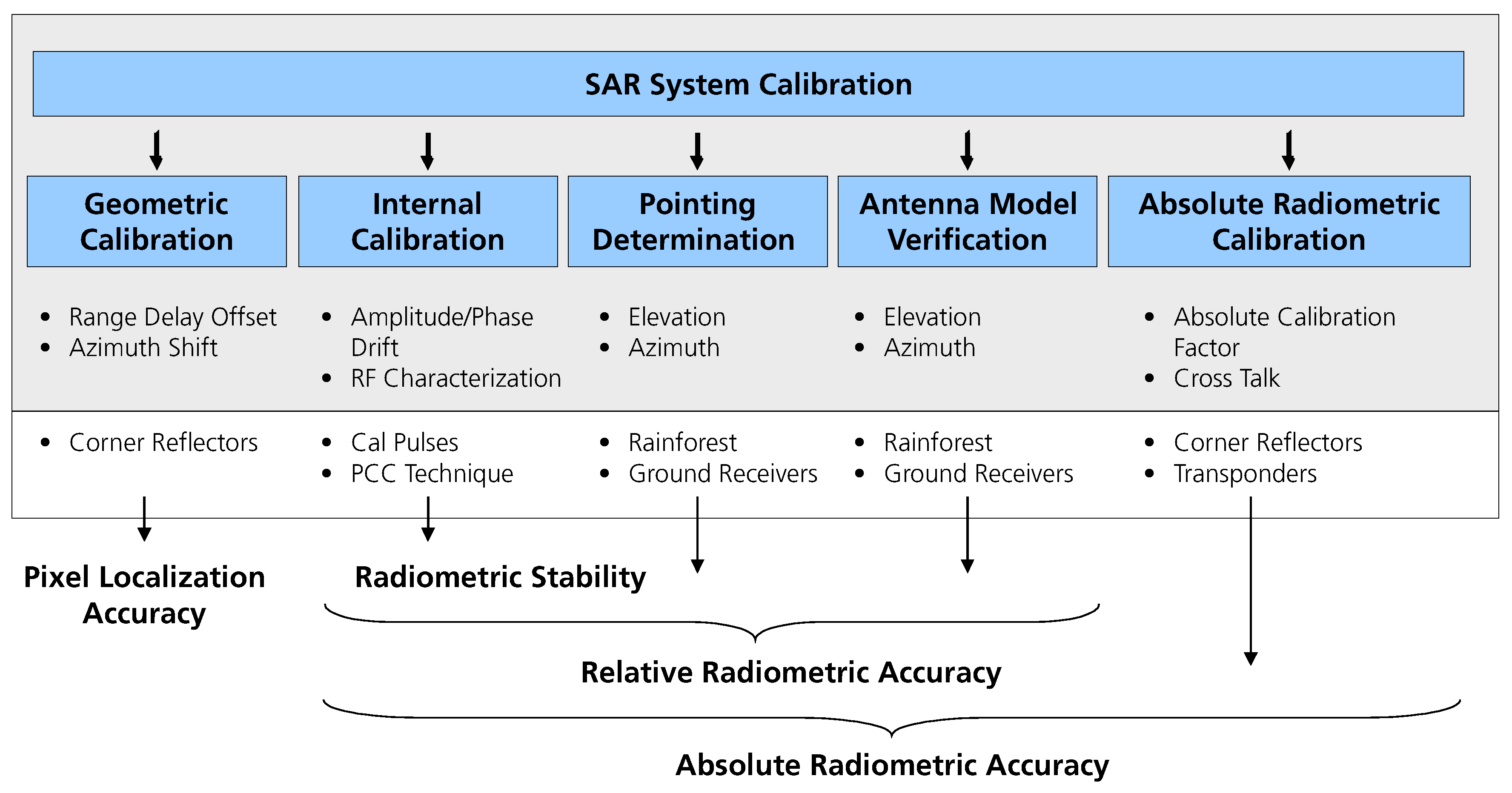
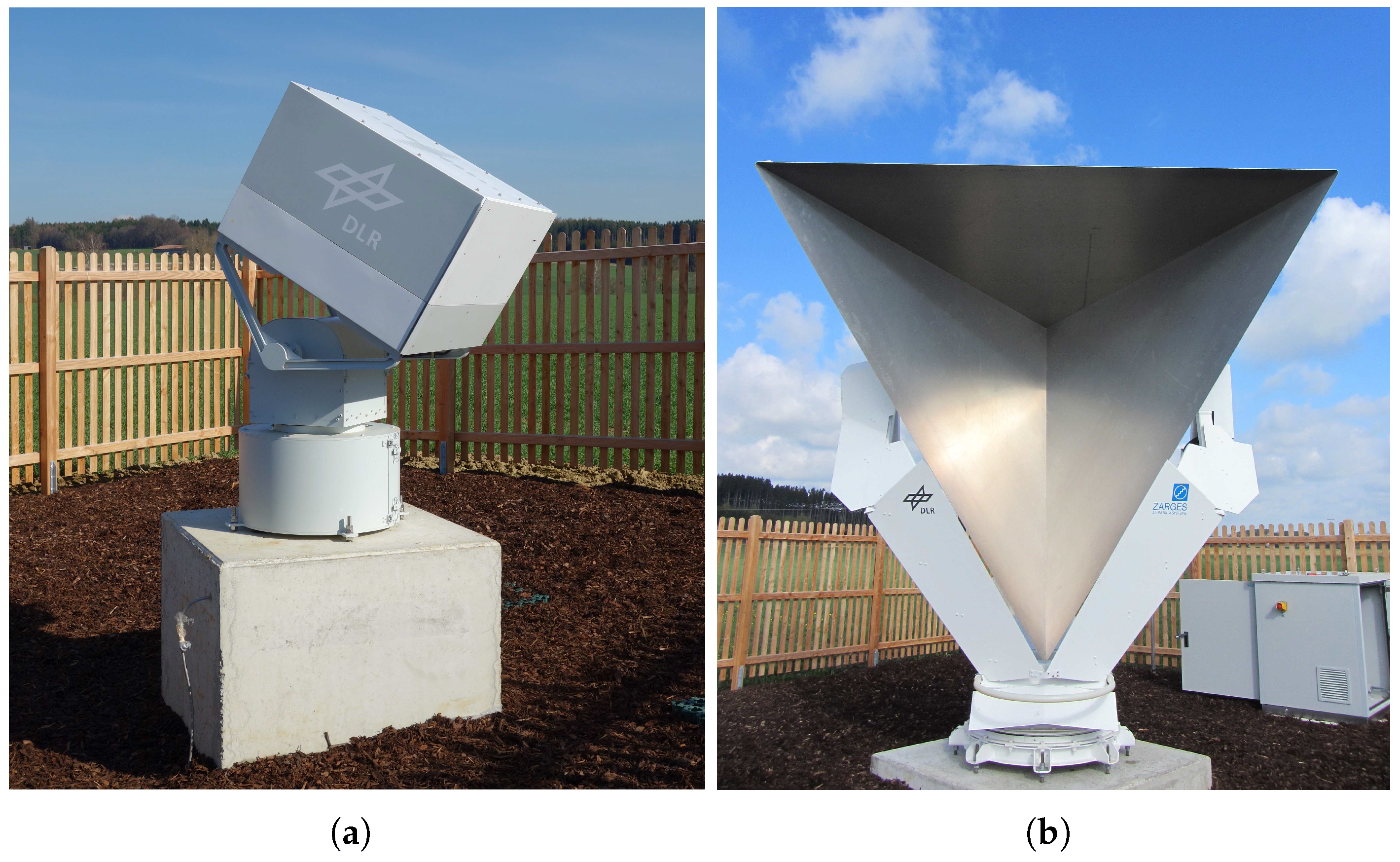
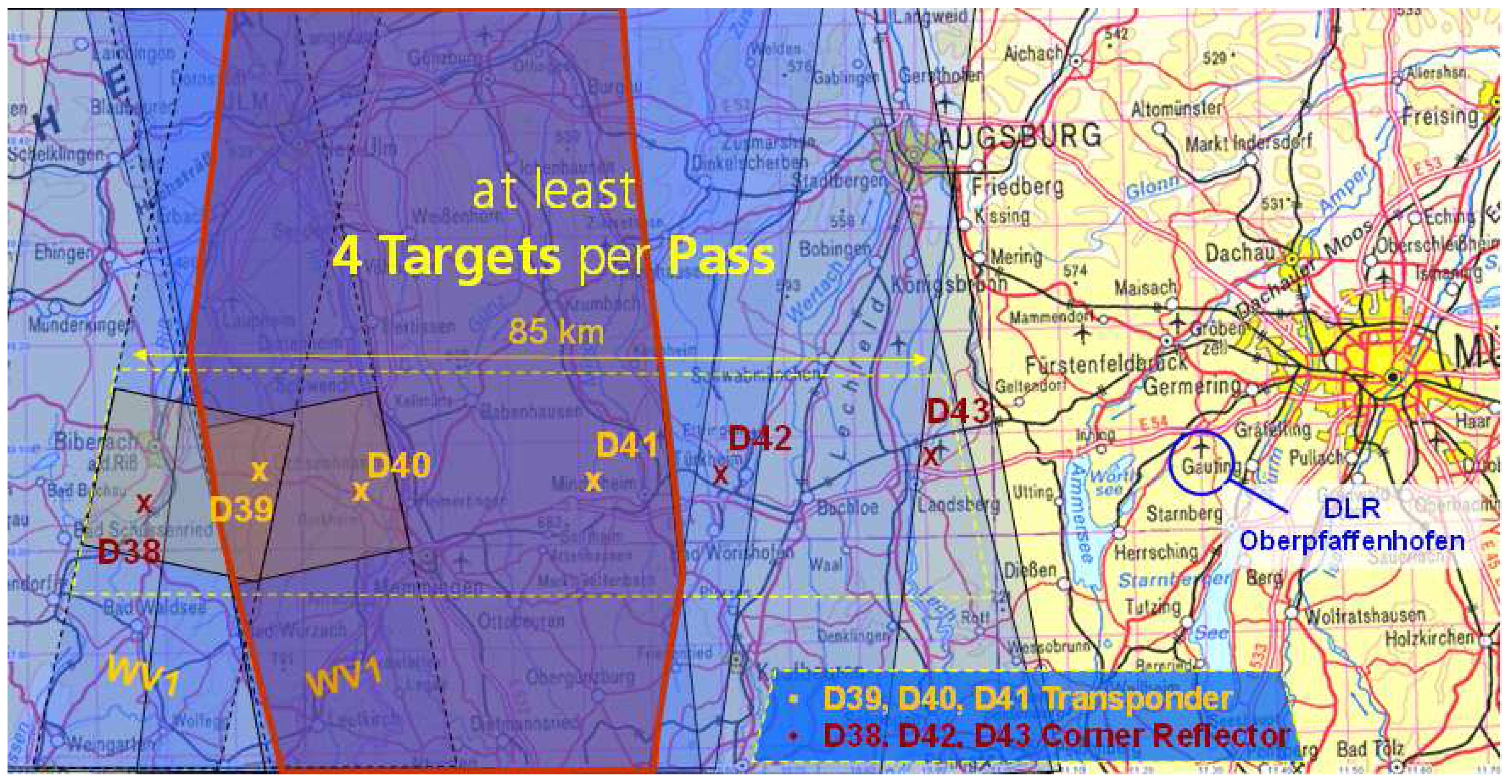
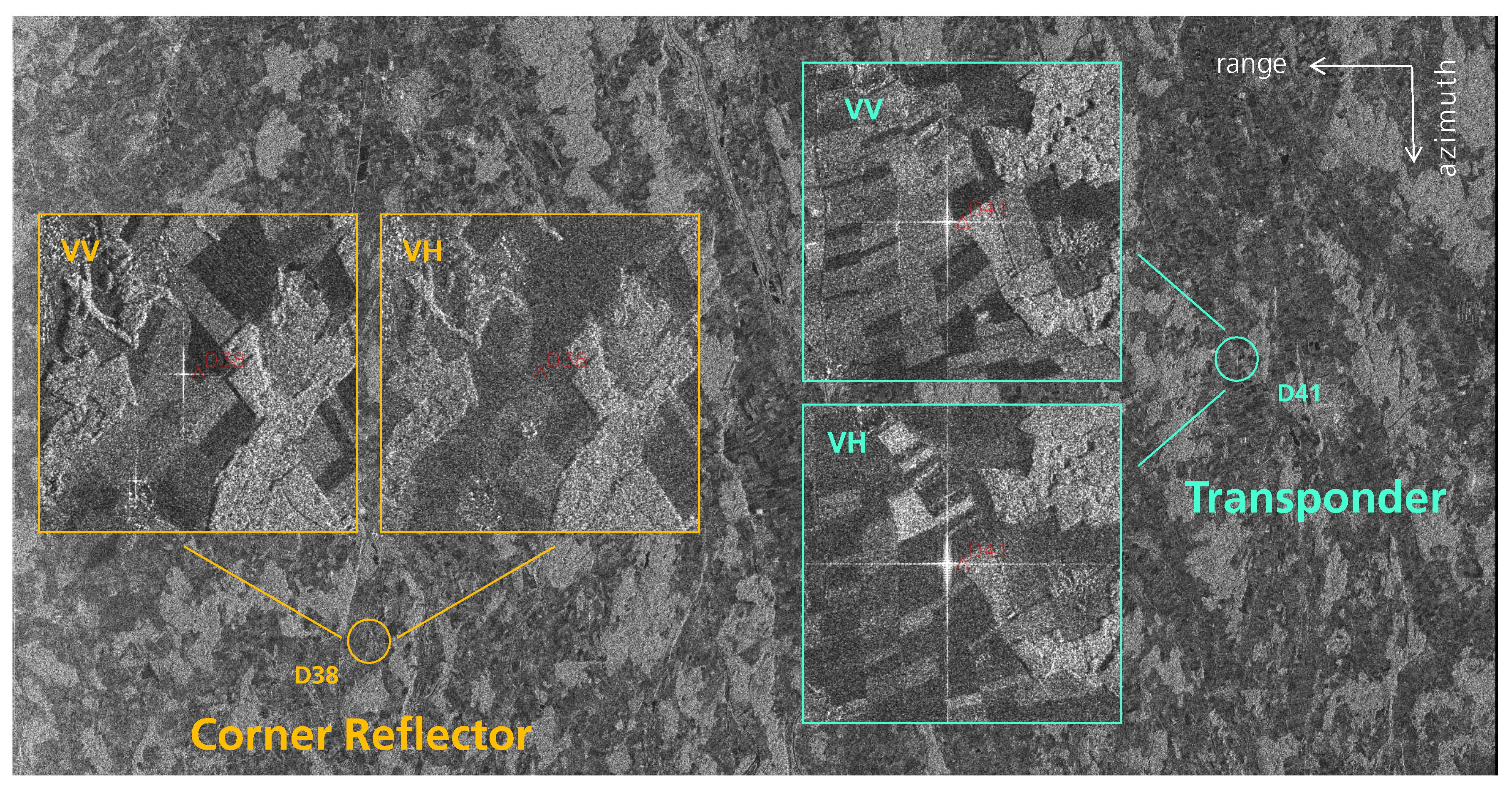

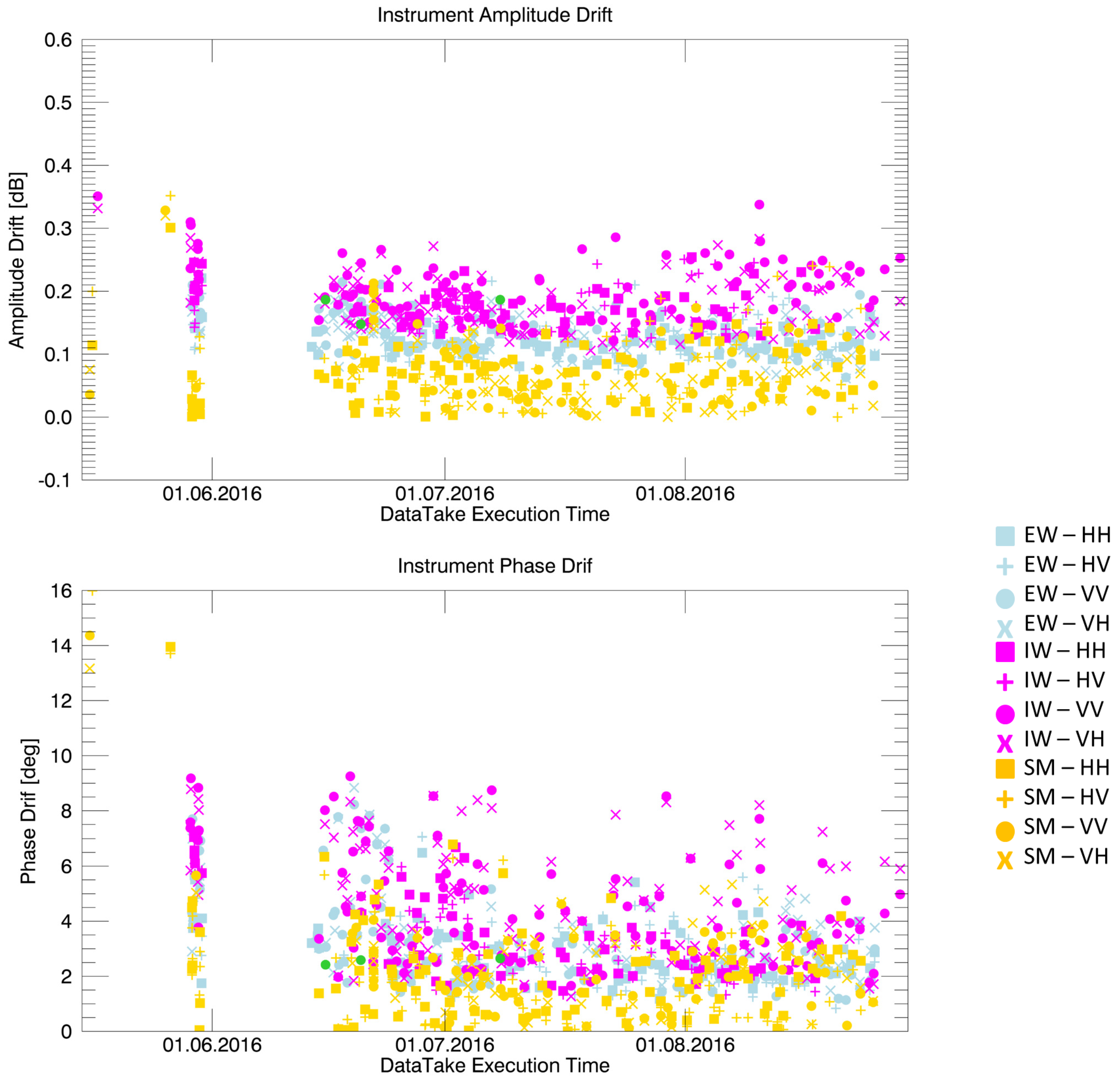

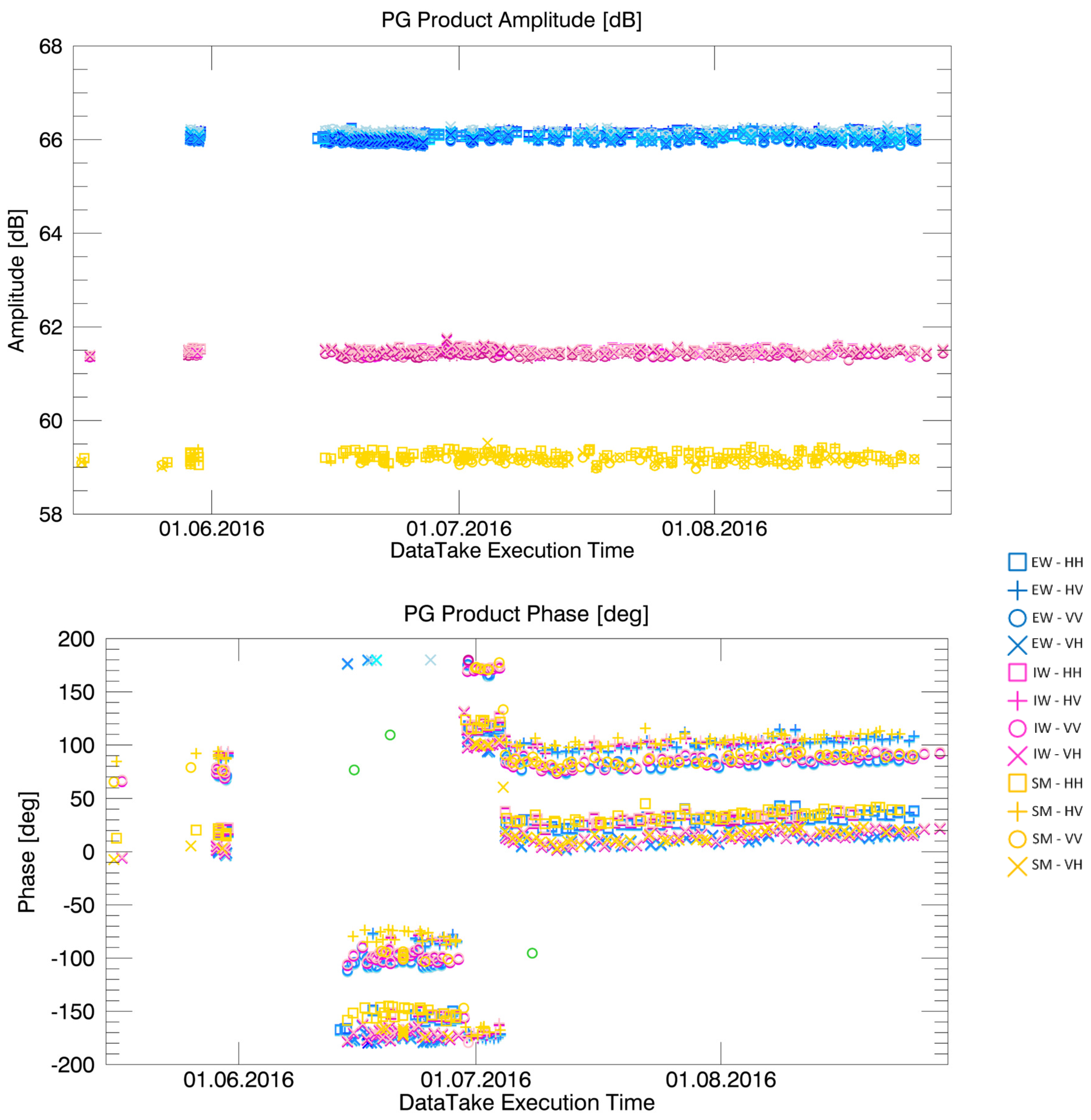
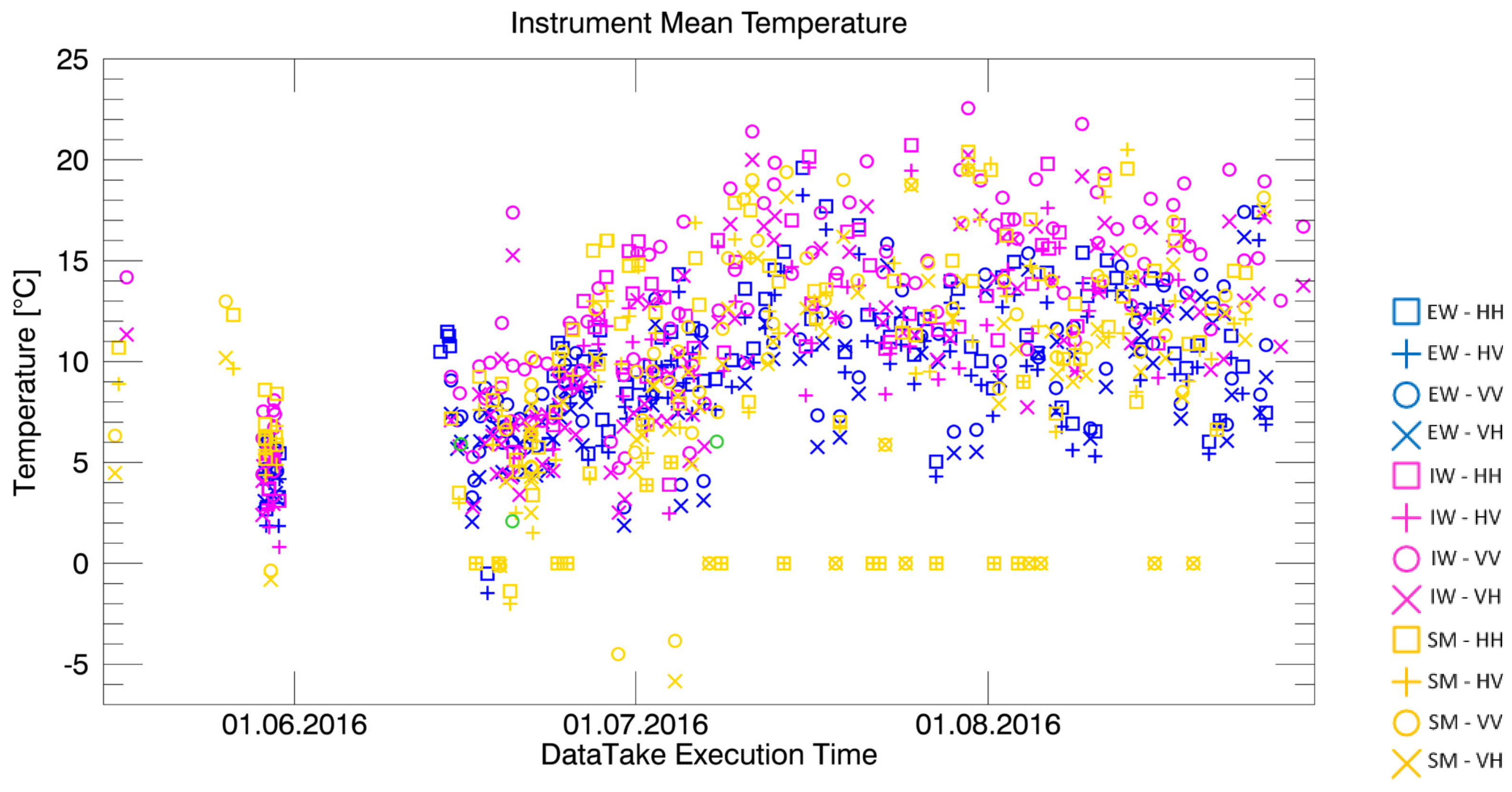
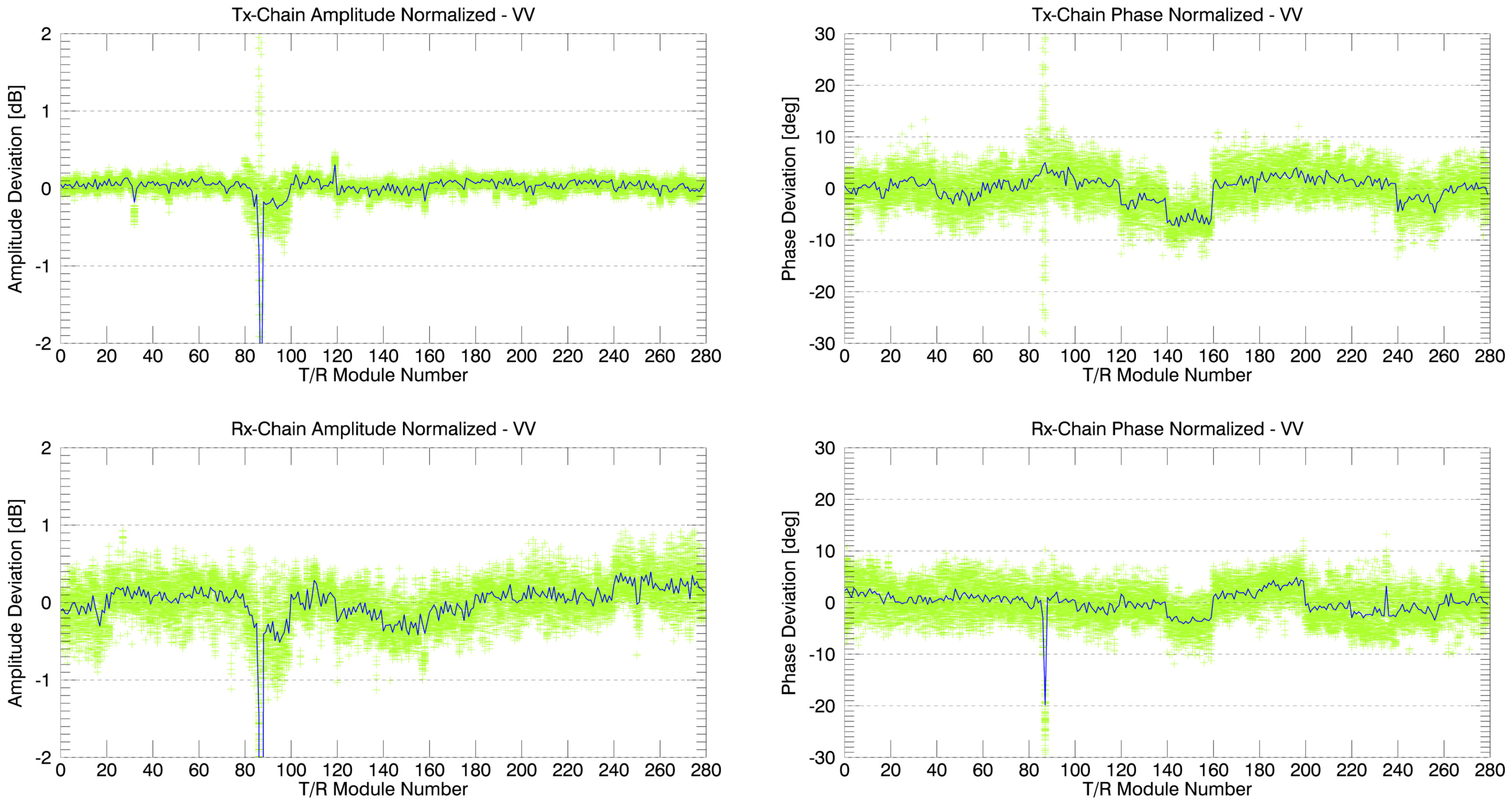
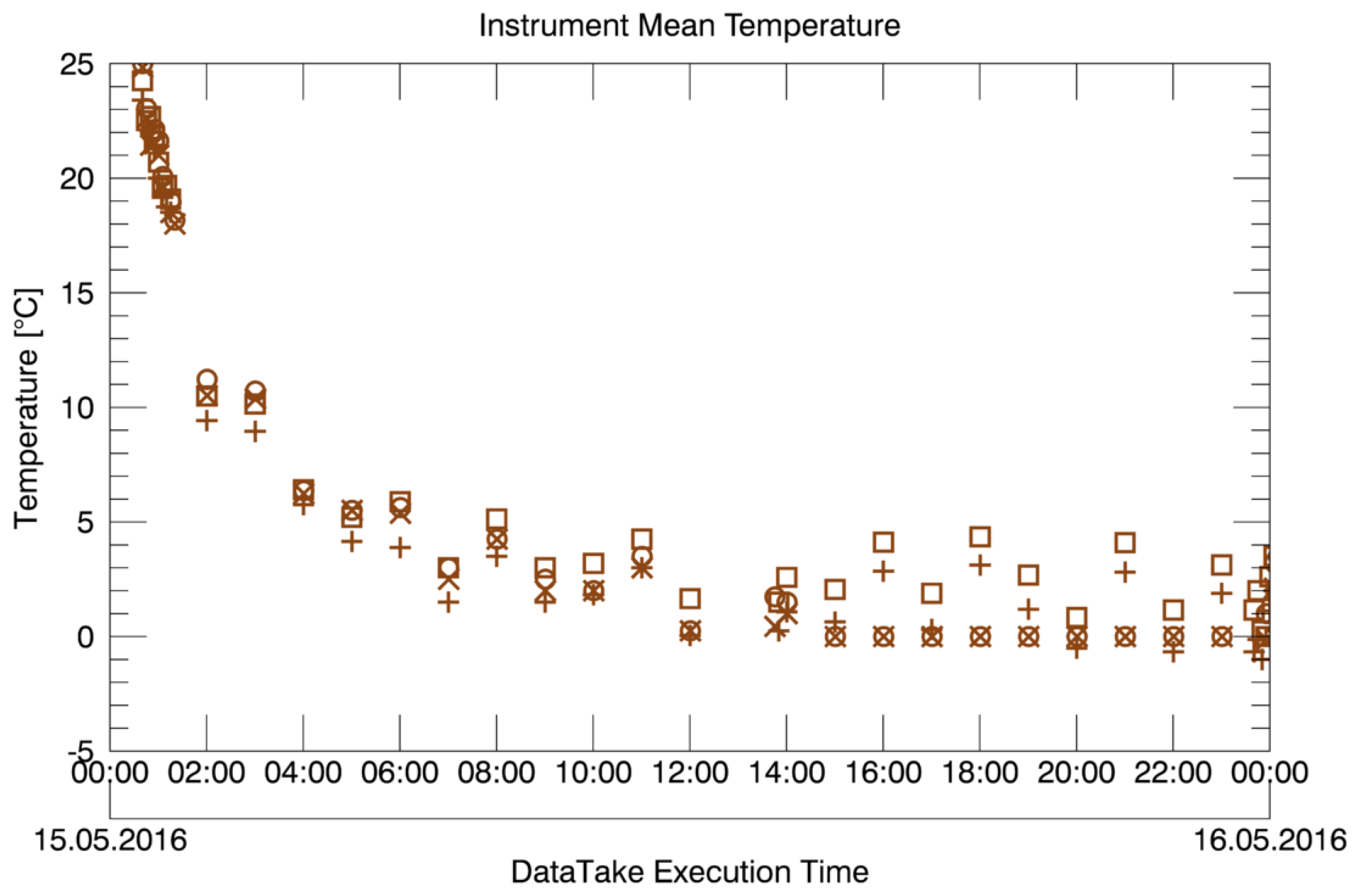
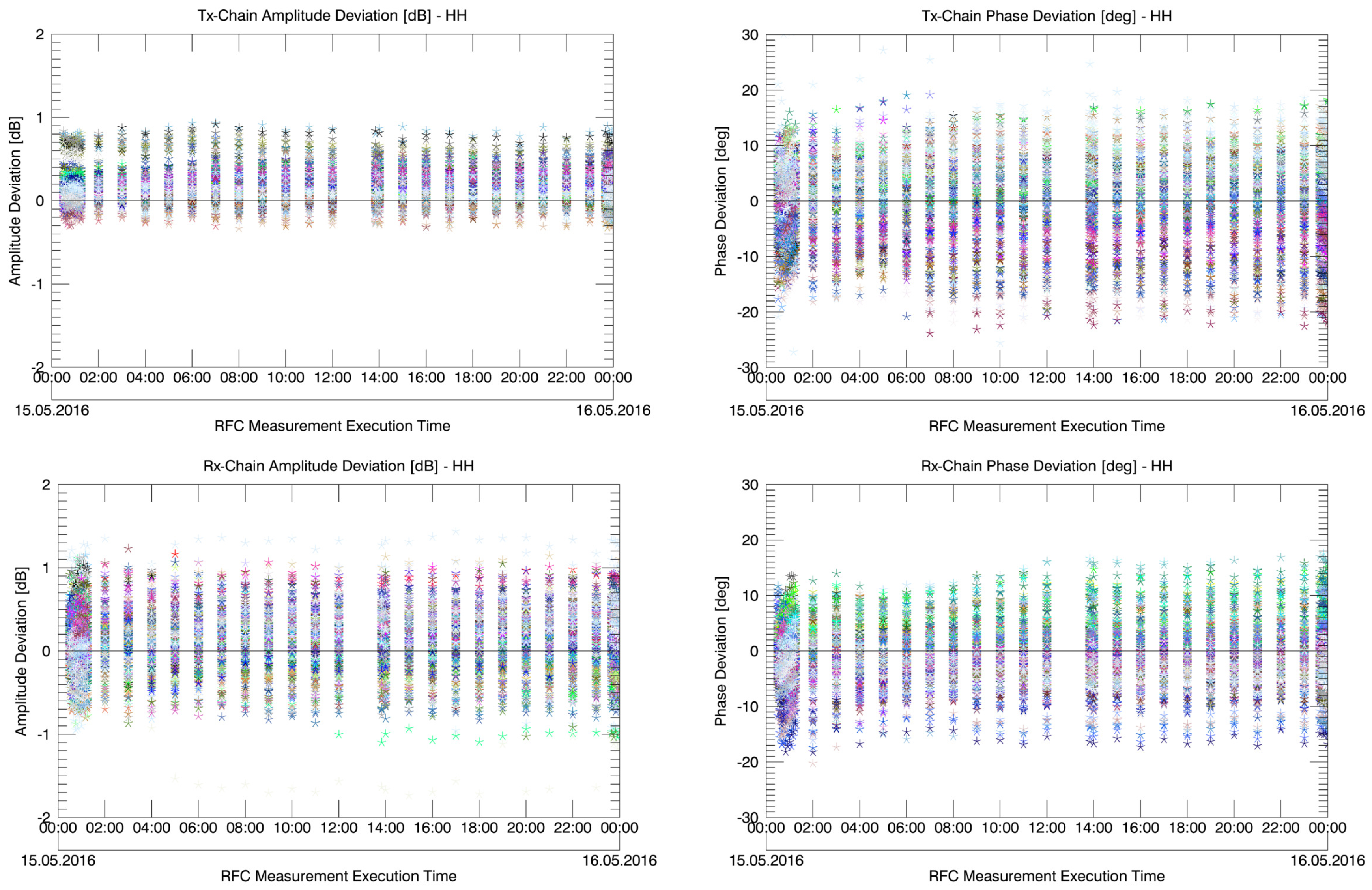
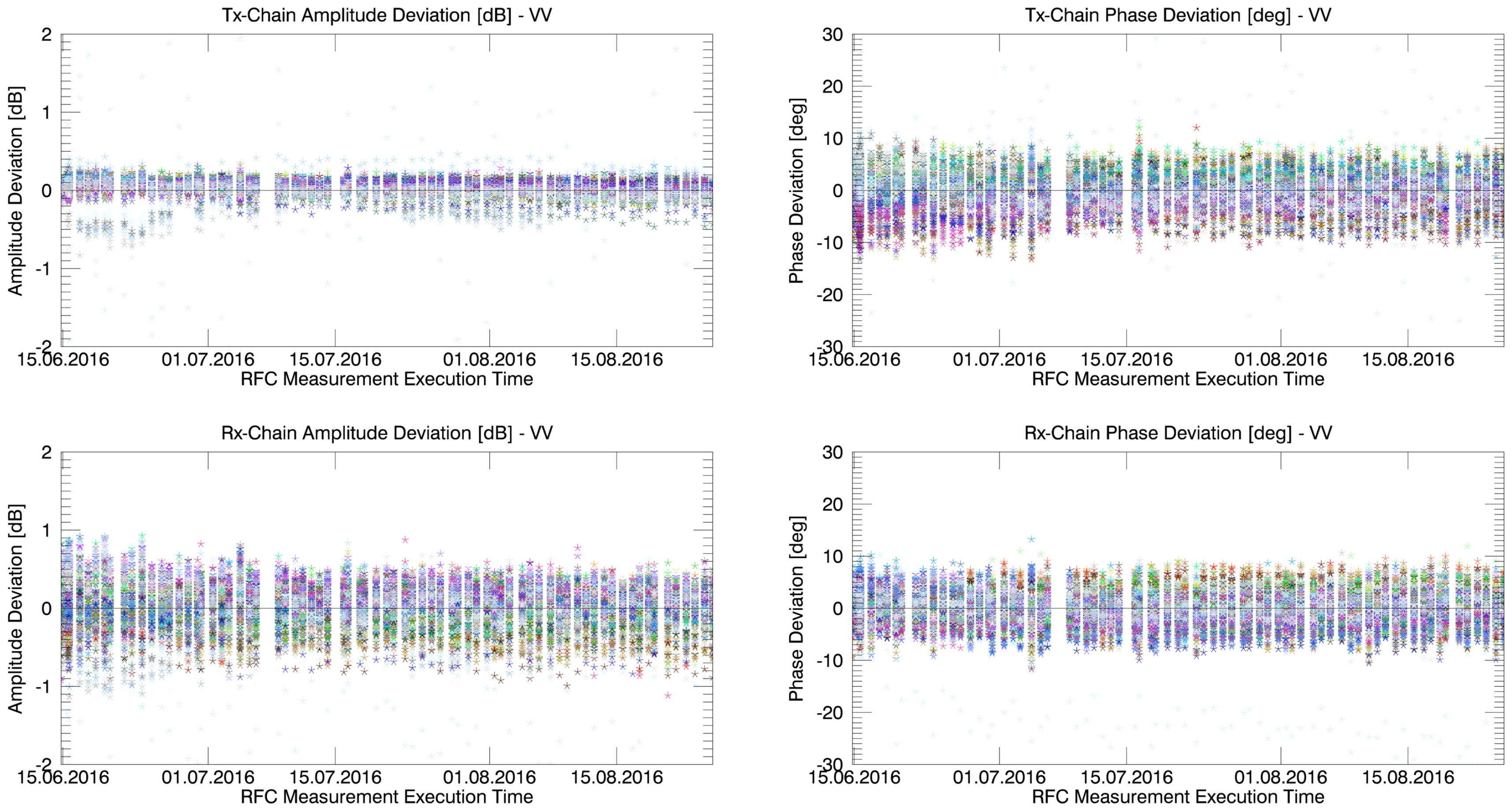
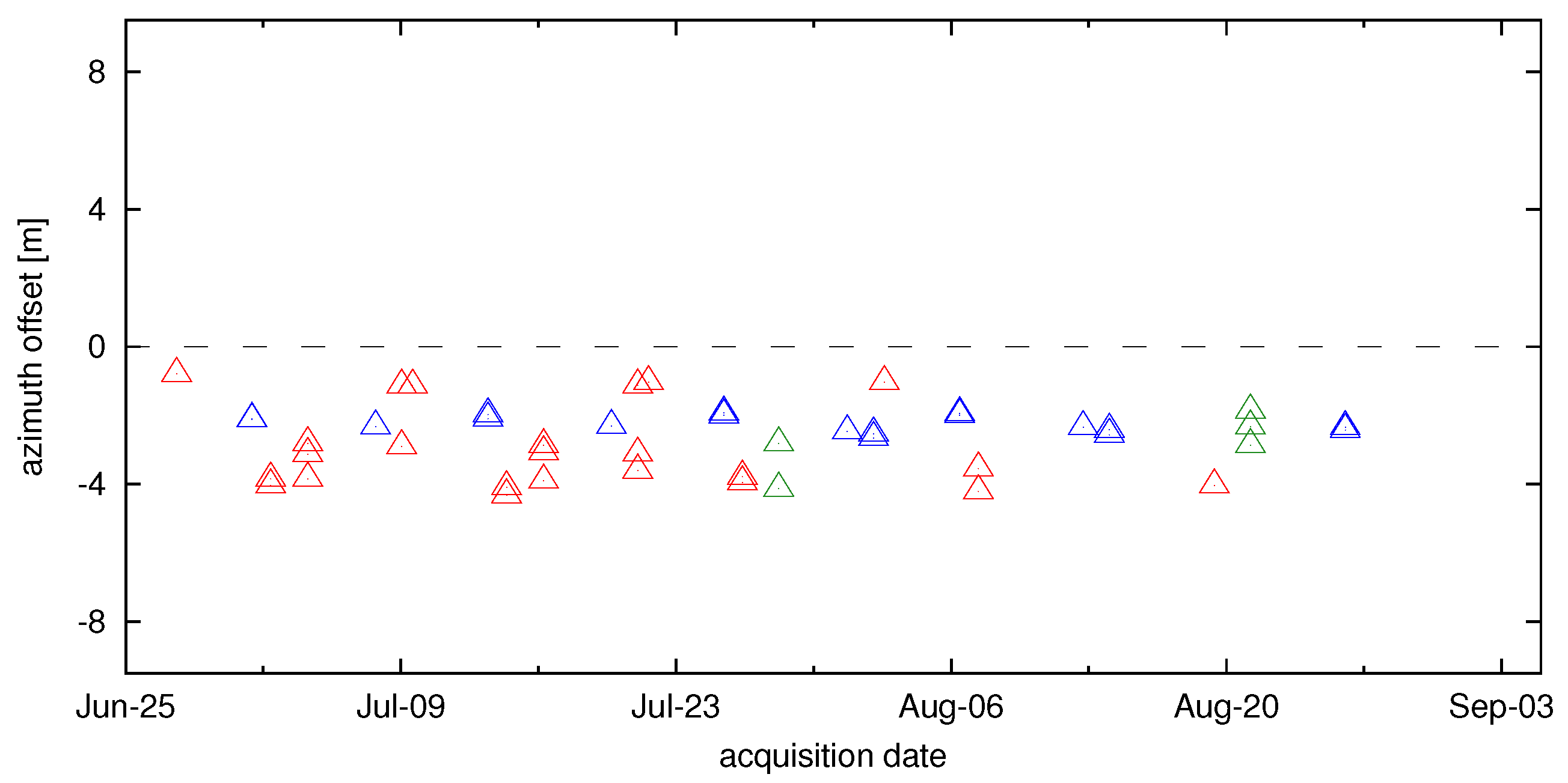
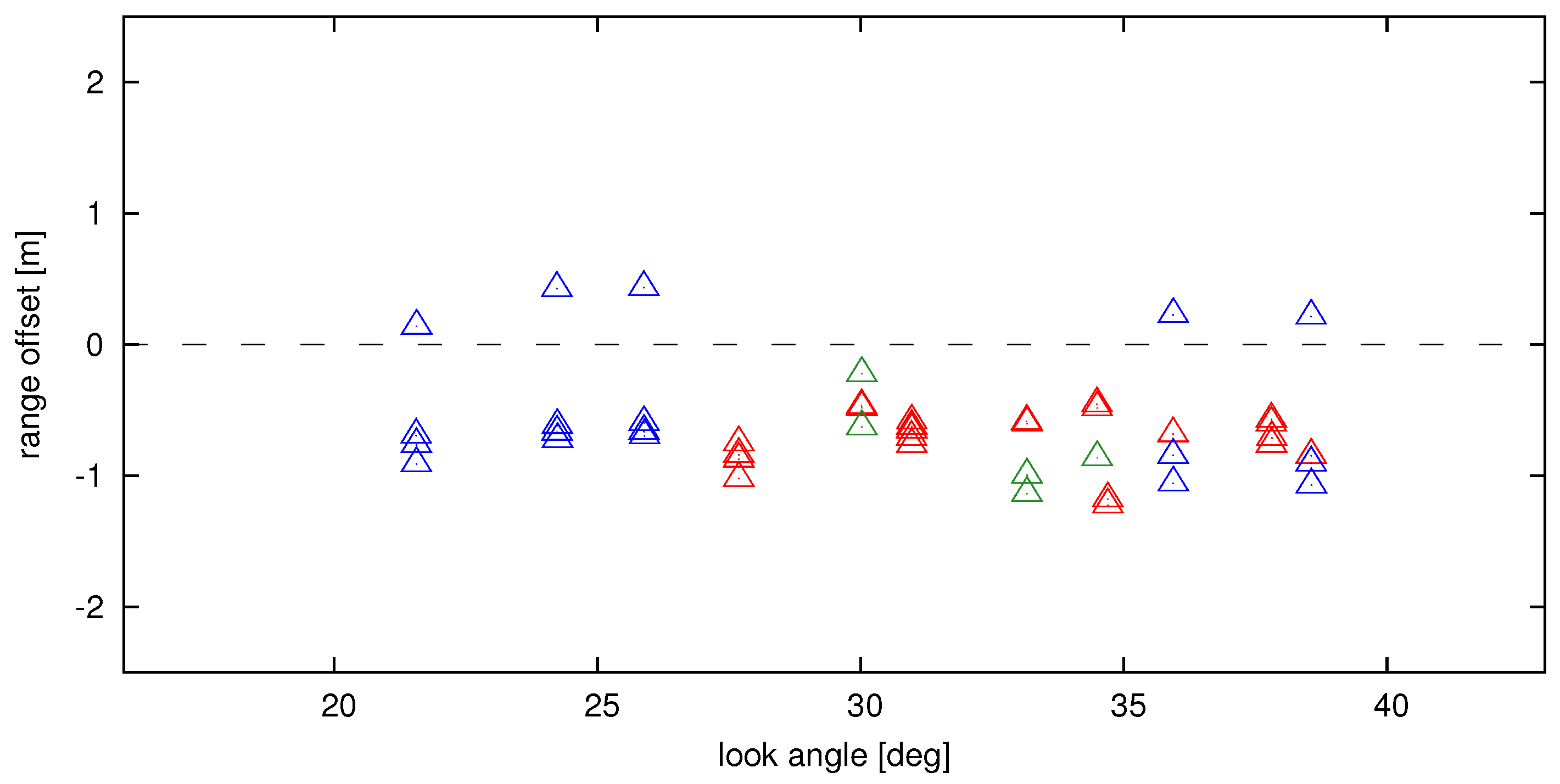
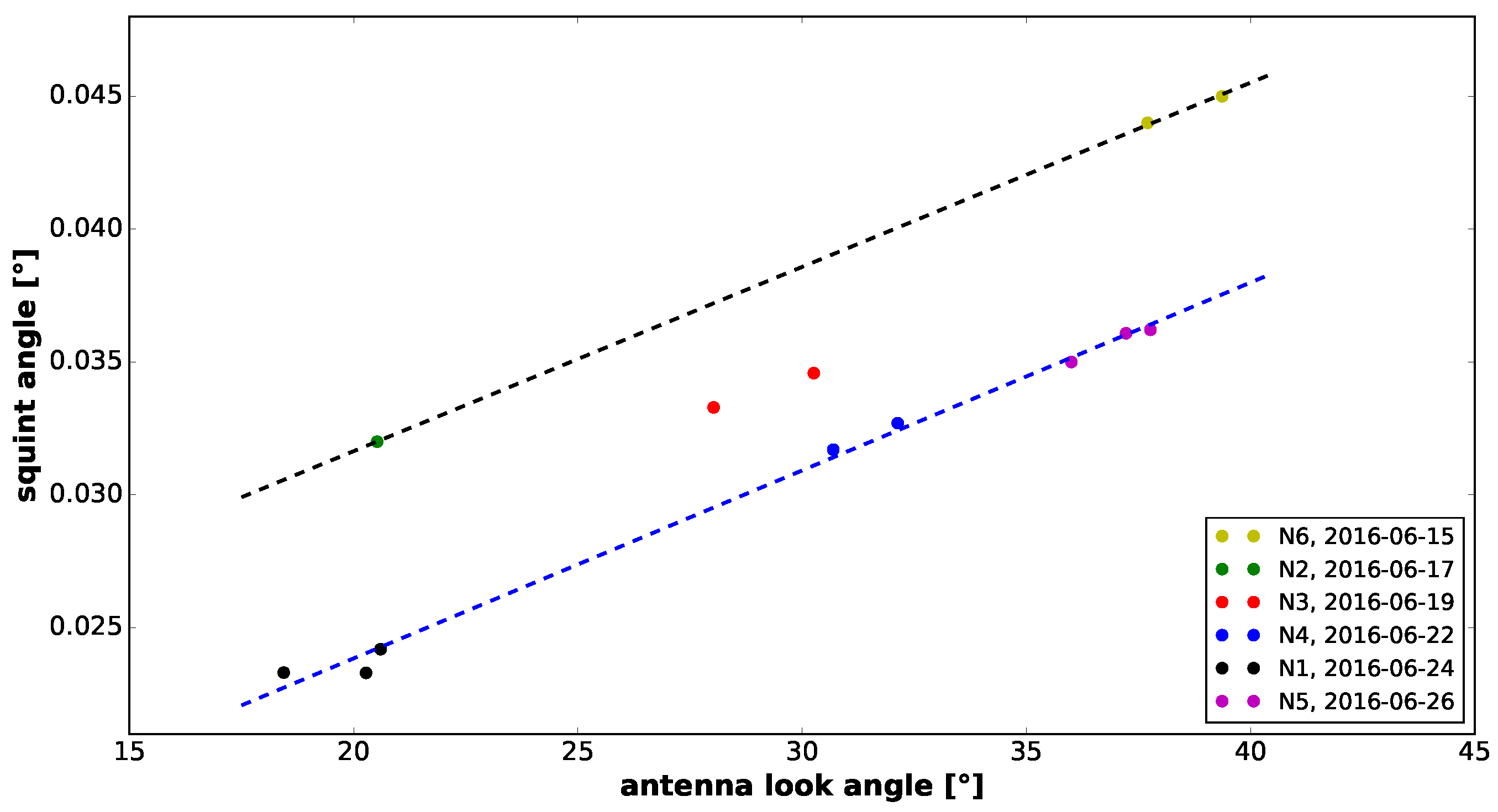
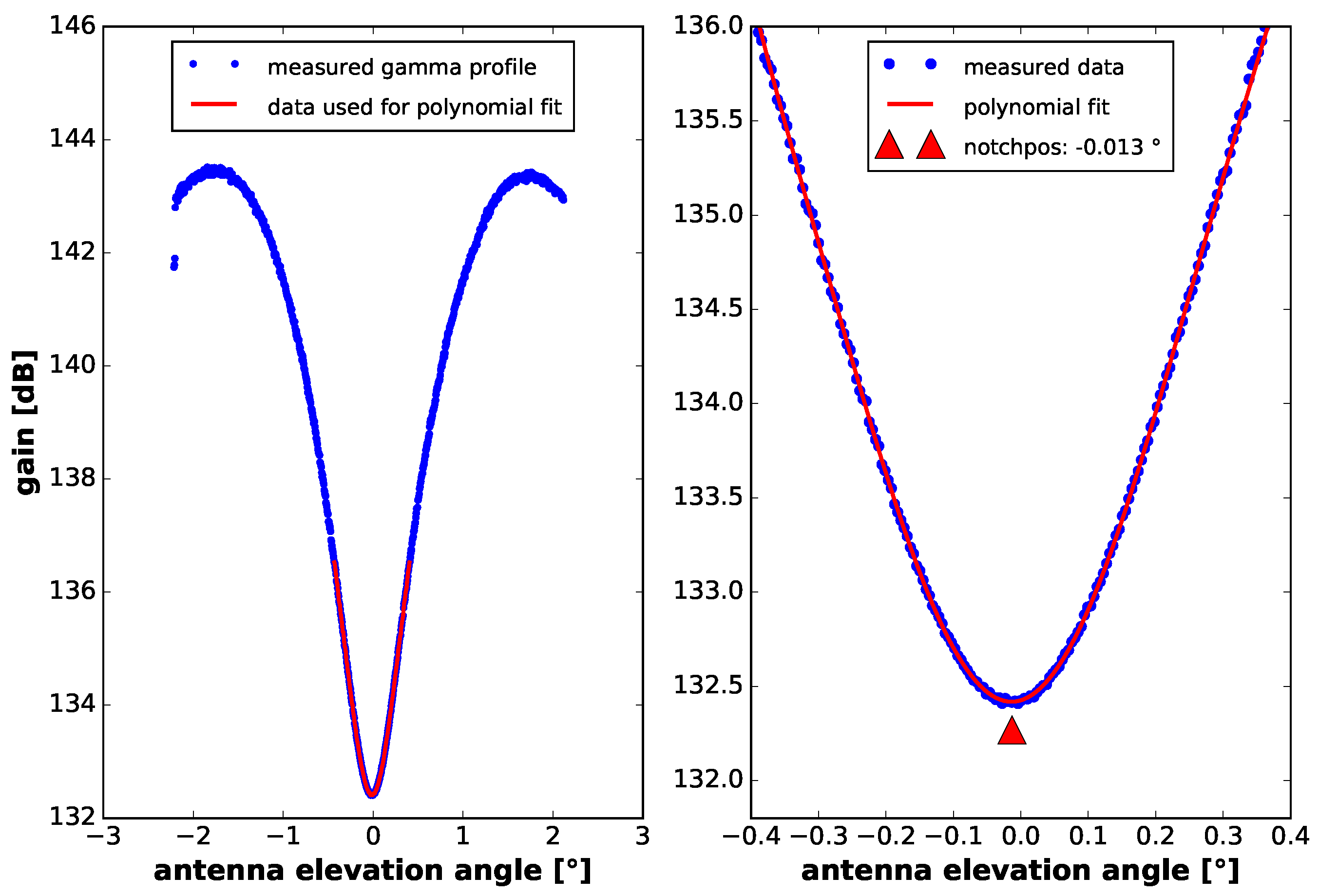
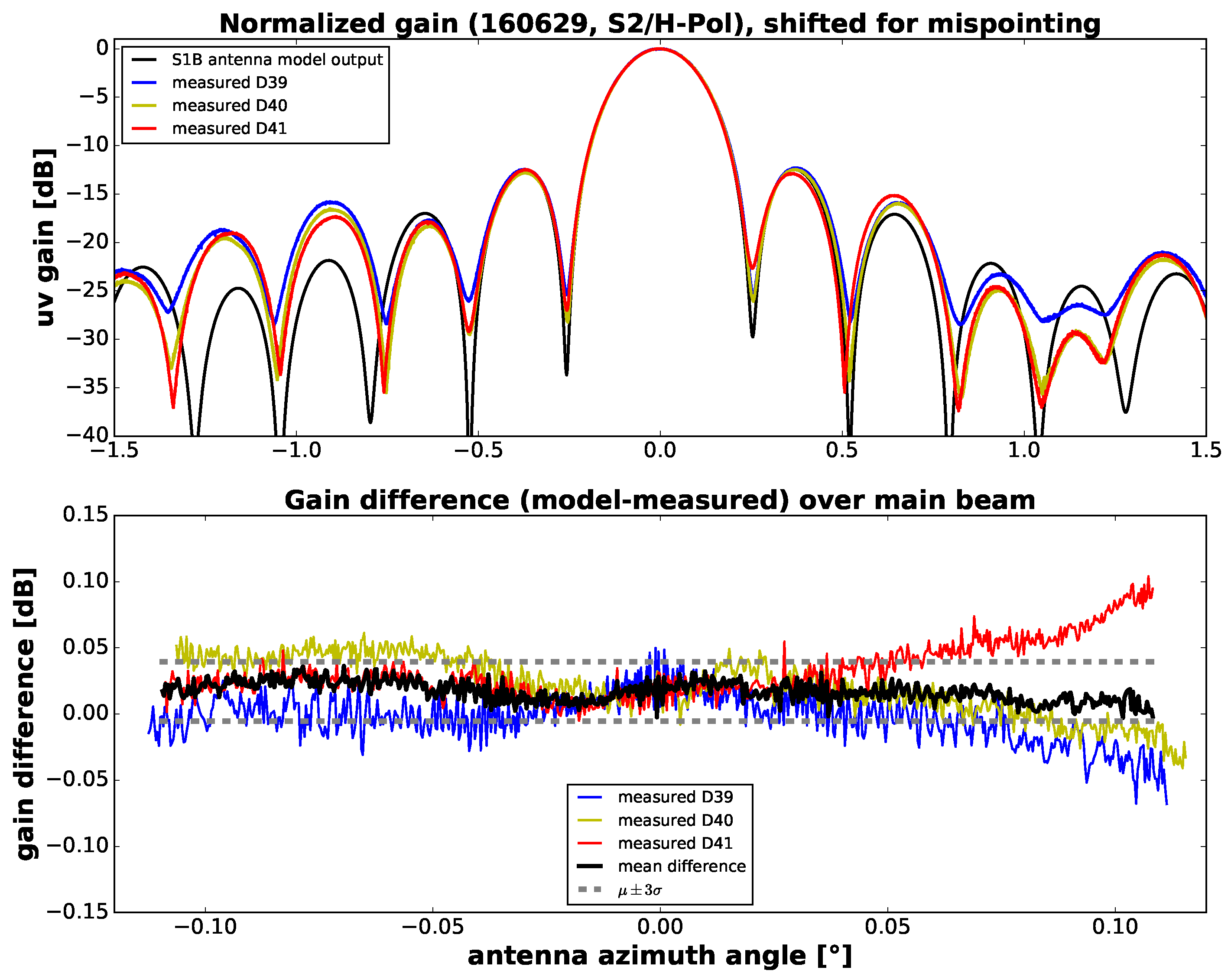
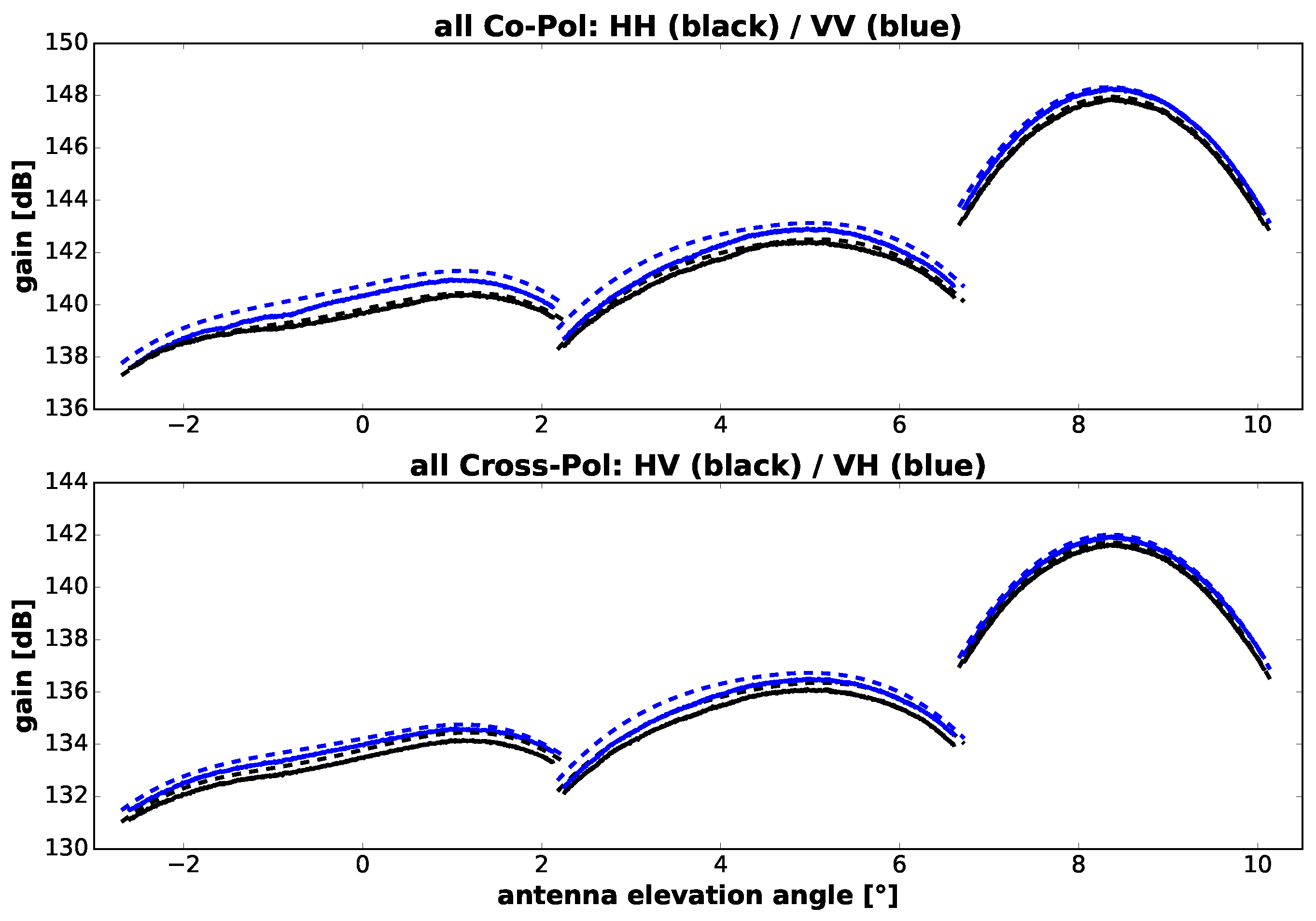
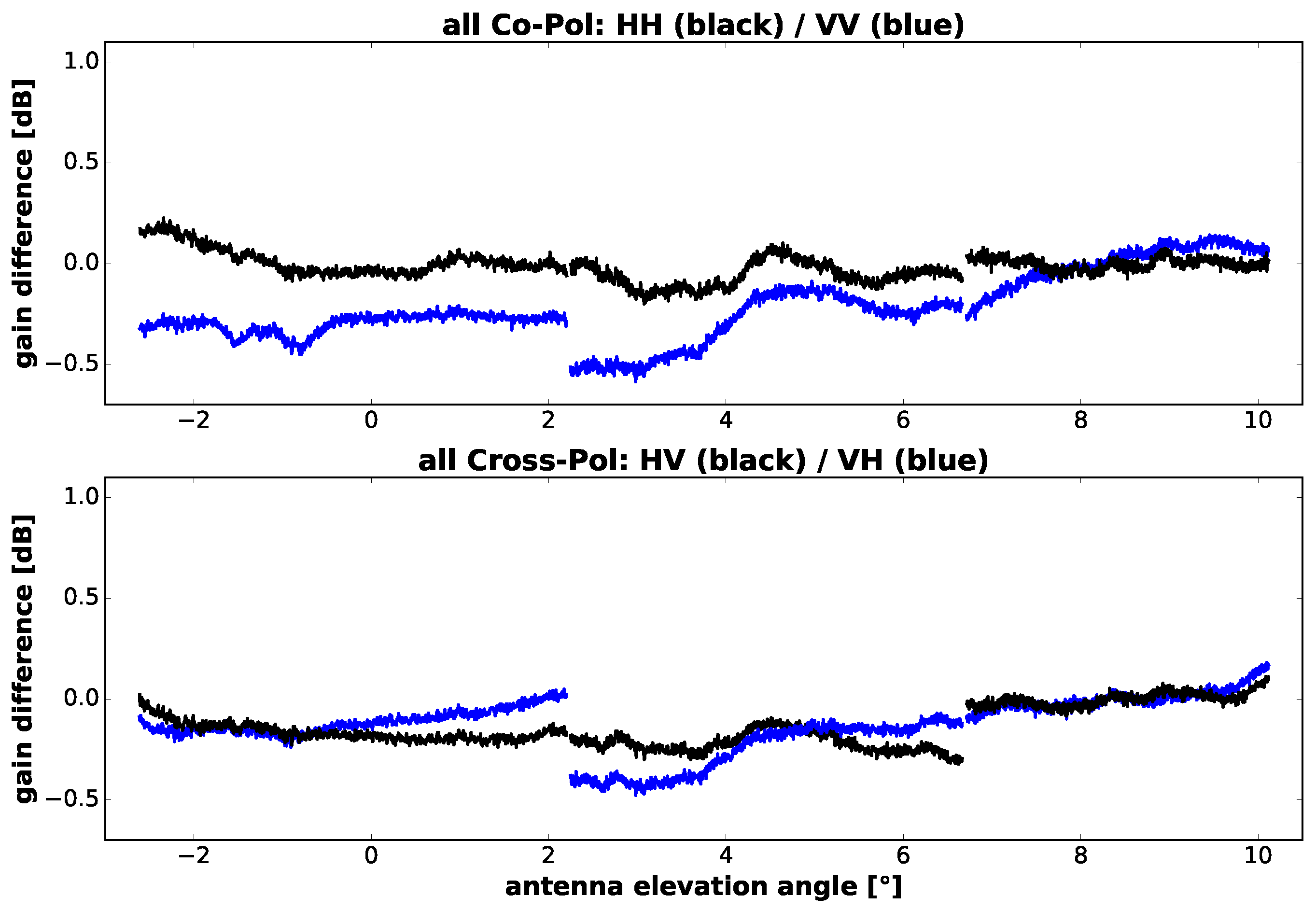
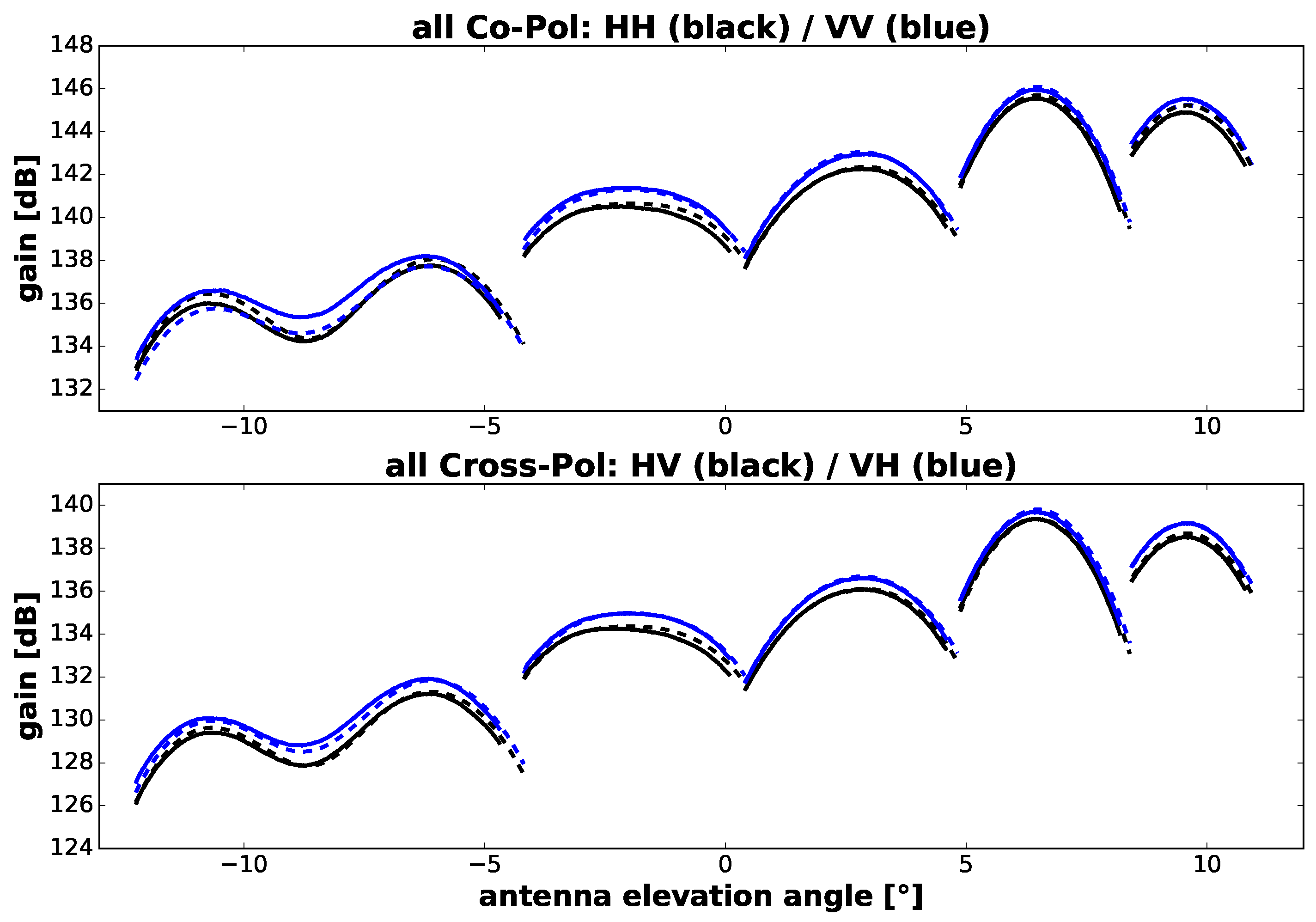

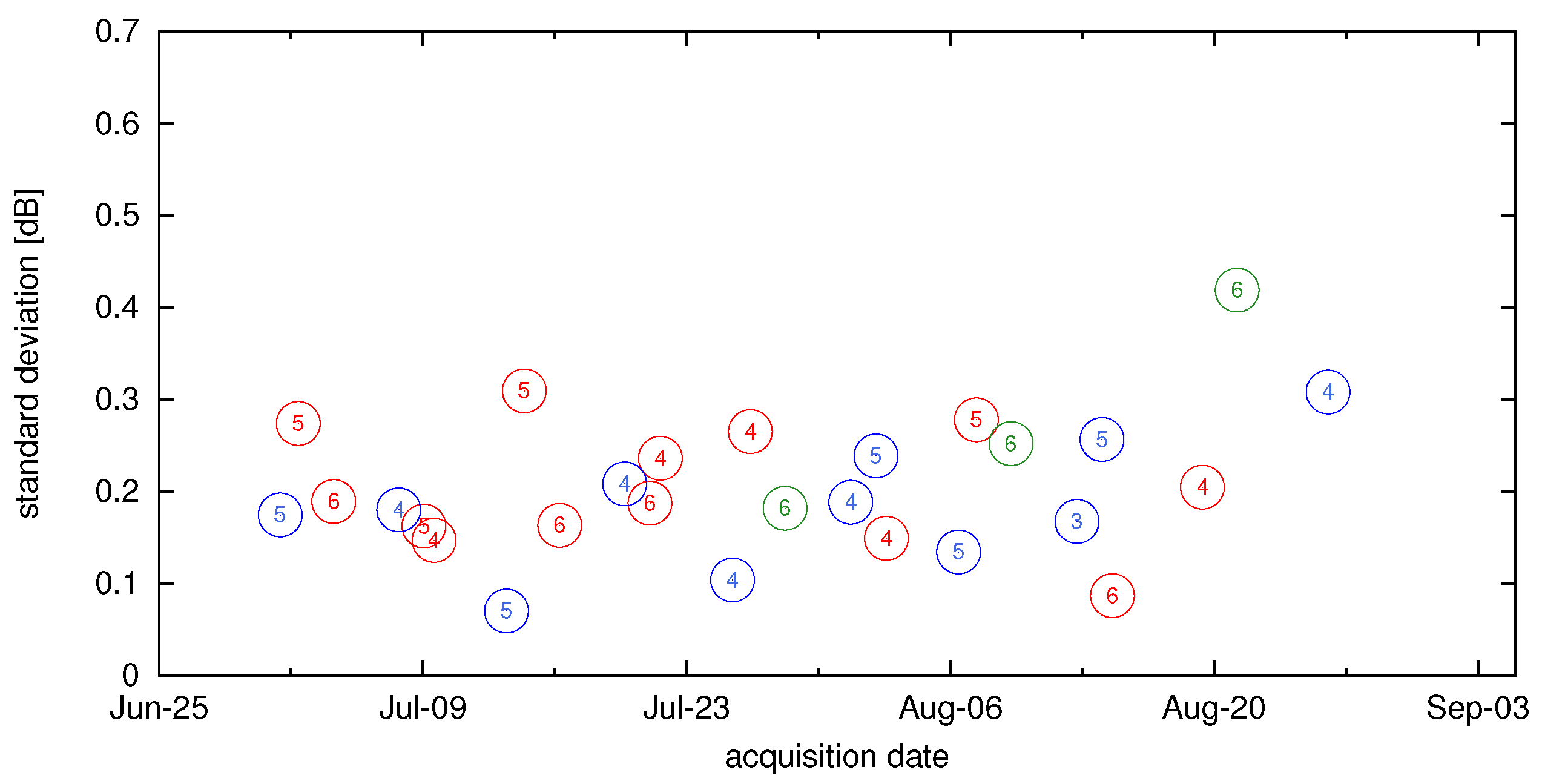


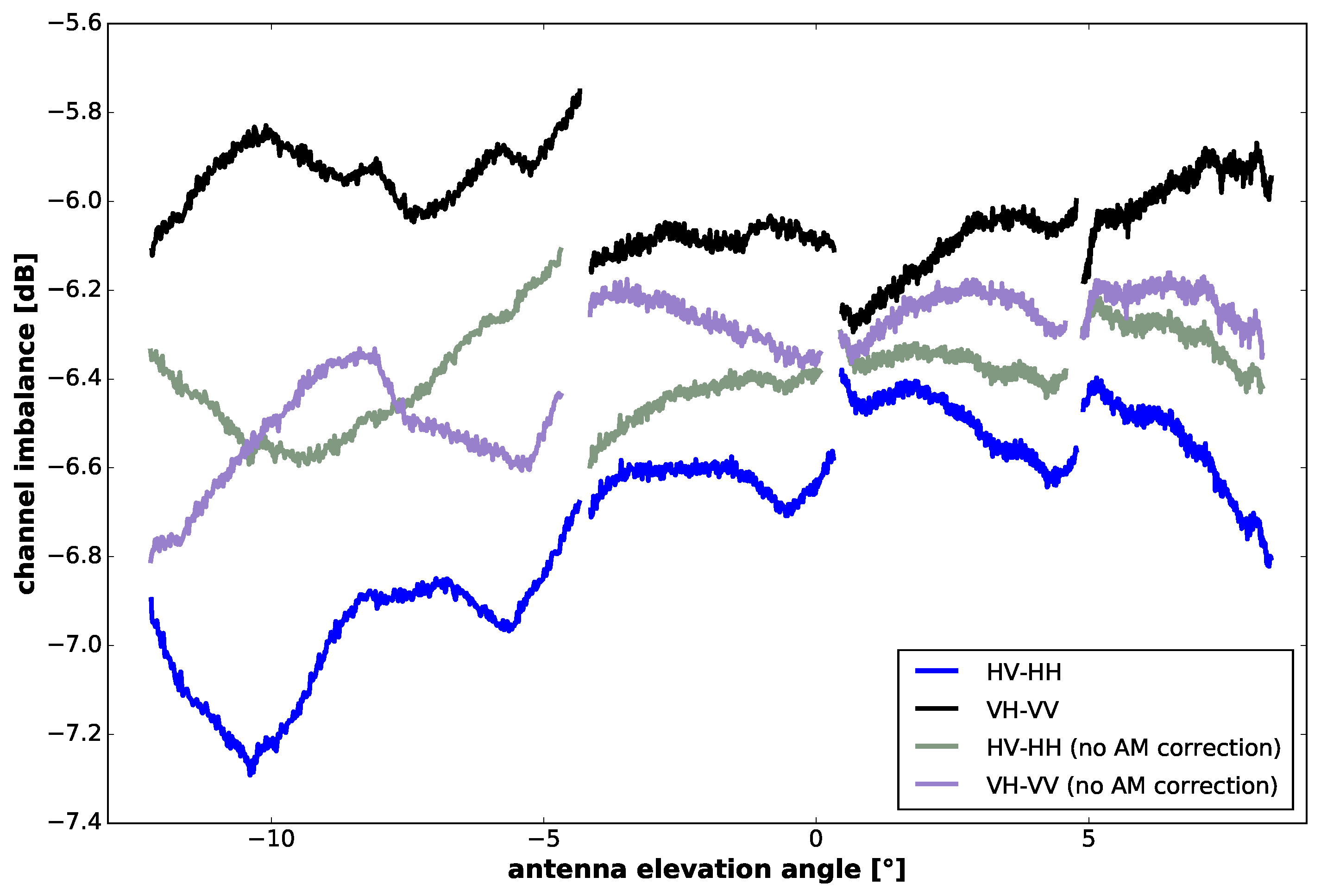
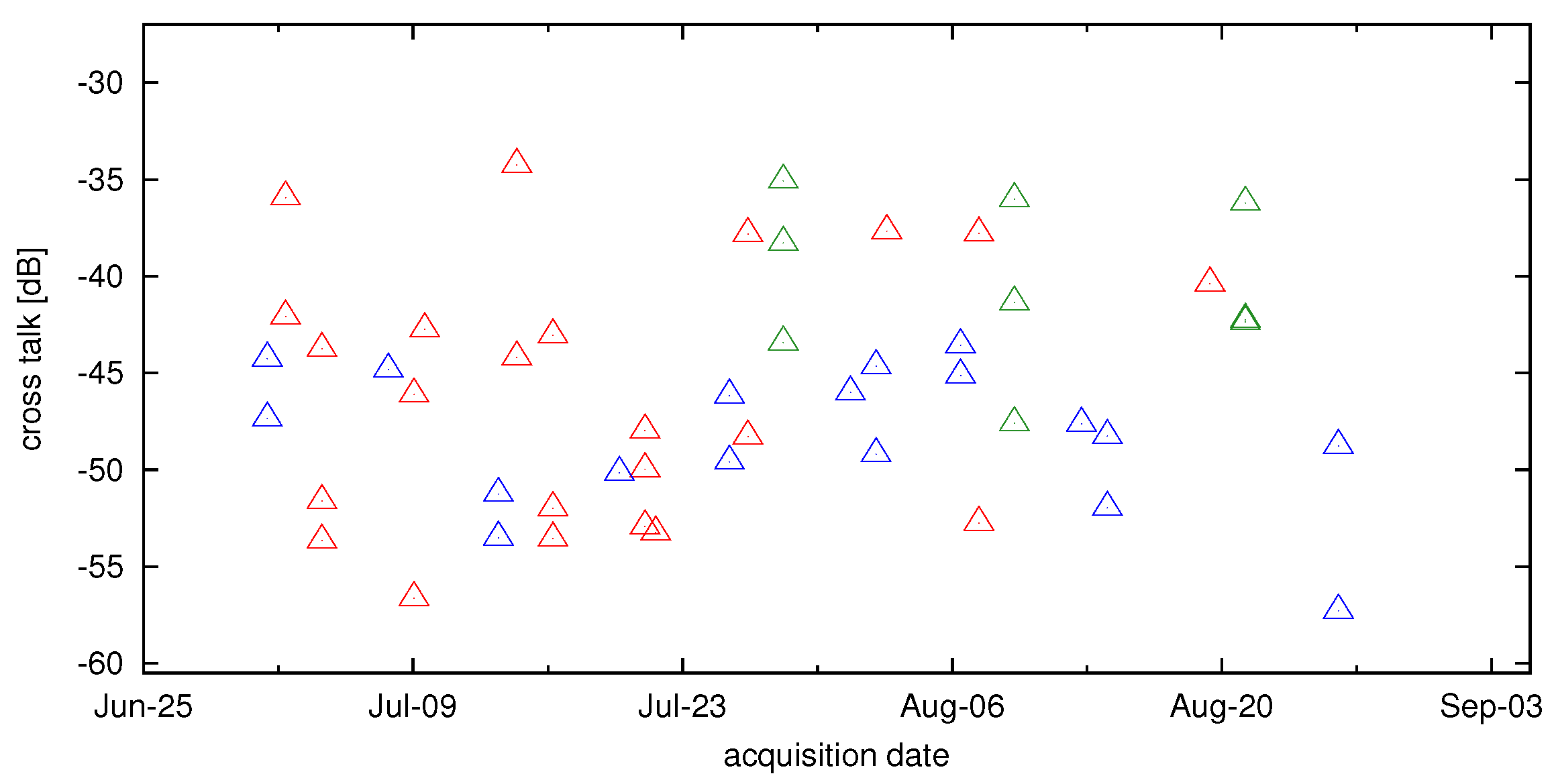
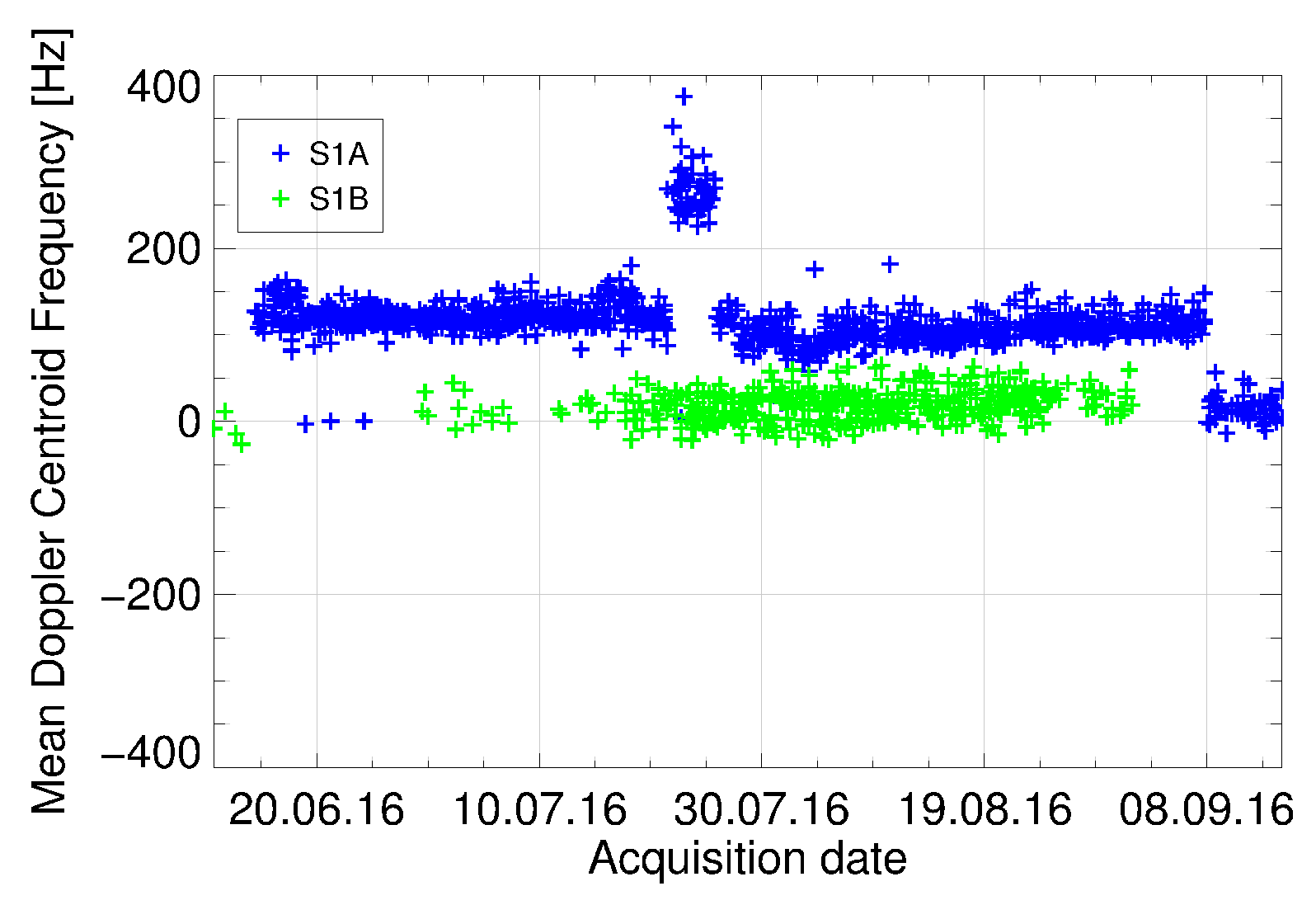
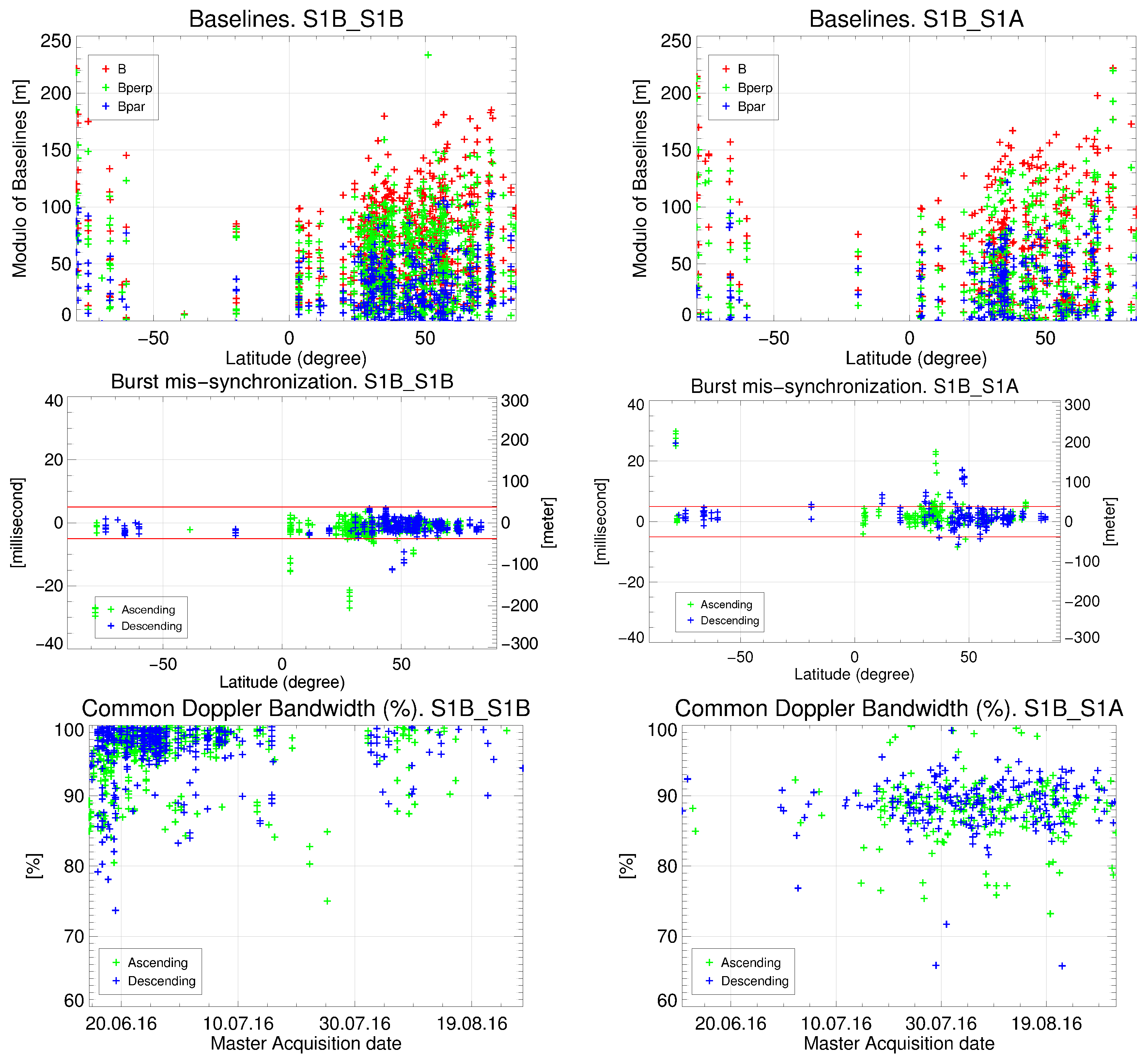
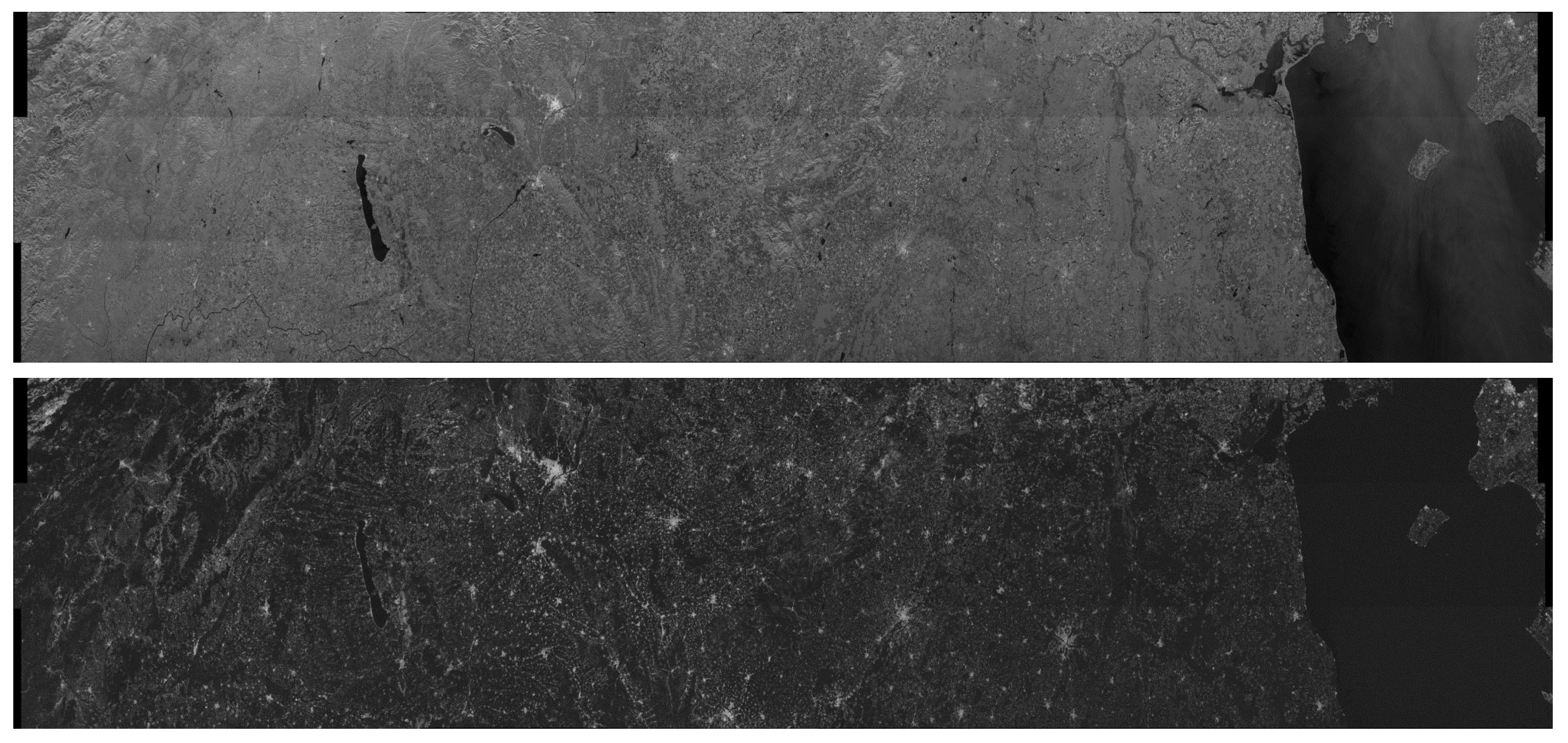

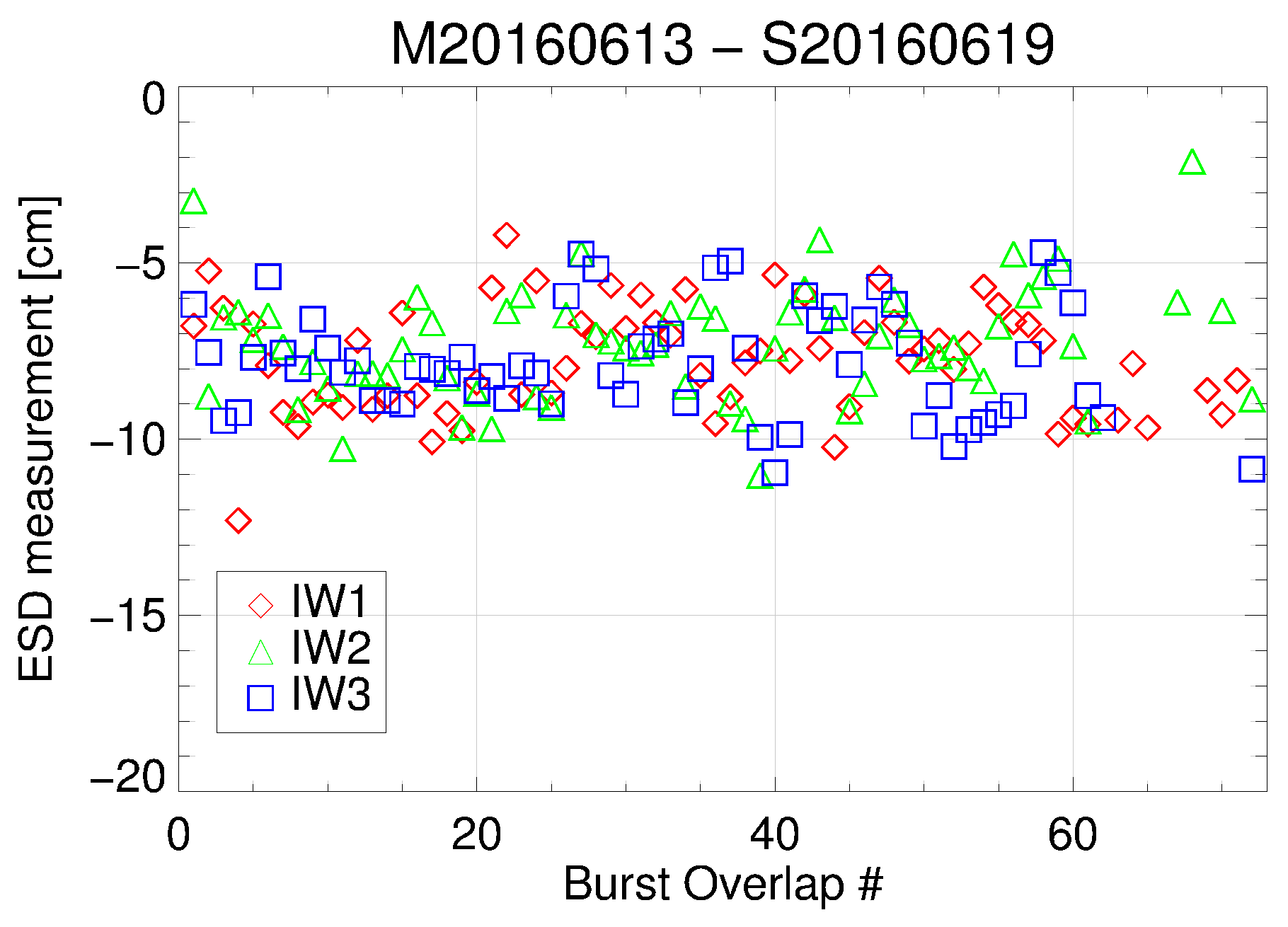
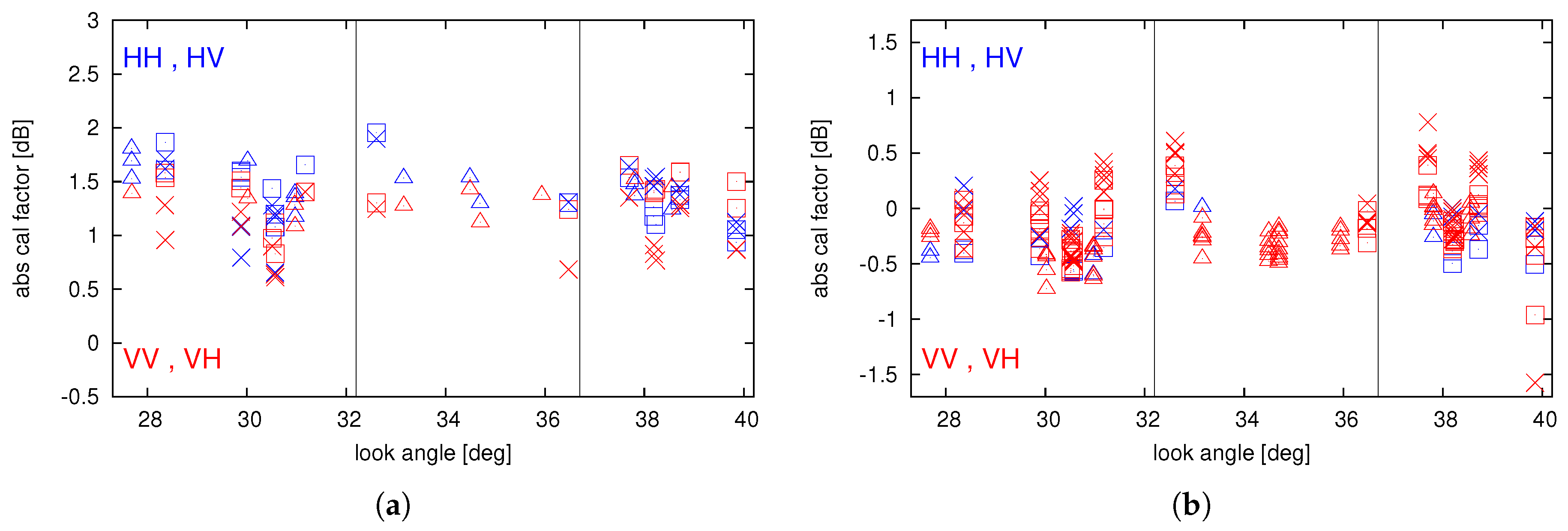
| IW | SM6 | SM6 | |
|---|---|---|---|
| Polarization | DV | DH | DV |
| Date | 17 May 2016 | 26 May 2016 | 25 May 2016 |
| Duration | 25 min | 25 min | 25 min |
| Mean Temp. | 14 C | 12 C | 13 C |
| Temp. Drift | 23 C | 20 C | 23 C |
| Amp. Drift | 0.25 dB | 0.2 dB | 0.23 dB |
| Phase Drift | 17.2 | 13.9 | 19.6 |
| Data Take | Swath | PREAMBLE | POSTAMBLE | Time Delay |
|---|---|---|---|---|
| SM DH | SM6 | 433.91 ns | 434.11 ns | 0.2 ns |
| 100 MHz | 433.70 ns | 433.81 ns | 0.11 ns | |
| SM DV | SM6 | 433.46 ns | 433.68 ns | 0.22 ns |
| 100 MHz | 433.51 ns | 433.65 ns | 0.14 ns | |
| Mean Value | 433.64 ns | 433.81 ns | 0.17 ns | |
| Standard Deviation | 0.18 ns | 0.18 ns | 0.04 ns | |
| Mode | Azimuth Offset | Range Offset | ||
|---|---|---|---|---|
| [m] | [m] | [m] | [m] | |
| SM | −2.2 | 0.2 | −0.5 | 0.5 |
| IW | −3.0 | 1.2 | −0.7 | 0.2 |
| EM | −2.8 | 0.8 | −0.7 | 0.3 |
| all | −2.7 | 1.0 | −0.6 | 0.4 |
| Datatake ID | Measurement Date | Pass | Polarization | Mispointing [mdeg] |
|---|---|---|---|---|
| 2283/1 (A495) | 13 August 2016 | asc. | HH | −11 |
| 2283/2 (3D2F) | 13 August 2016 | asc. | HH | −11 |
| 2283/3 (F631) | 13 August 2016 | asc. | HH | −13 |
| 2283/4 (4932) | 13 August 2016 | asc. | HH | −21 |
| 2380/1 (5279) | 15 August 2016 | desc. | VV | −16 |
| 2380/2 (9CBA) | 15 August 2016 | desc. | VV | −17 |
| 25D2/1 (A9C4) | 18 August 2016 | asc. | HH | −13 |
| 25D2/2 (ED0E) | 18 August 2016 | asc. | HH | −13 |
| 25D2/3 (05D5) | 18 August 2016 | asc. | HH | −13 |
| 25D2/4 (B0C9) | 18 August 2016 | asc. | HH | −19 |
| 26F5/2 (3311) | 20 August 2016 | asc. | VV | −18 |
| 26F5/3 (52FF) | 20 August 2016 | asc. | VV | −18 |
| 26F5/4 (DF60) | 20 August 2016 | asc. | VV | −16 |
| −15 ± 3 |
| Measurement Date | Swath Type | Transmit Polarization | Model-Measured over Main Beam/ [dB] |
|---|---|---|---|
| 29 June 2016 | SM2 | H | 0.035 (3 transponder average) |
| 6 July 2016 | SM1 | H | 0.031 (1 transponder) |
| 11 July 2016 | SM2 | V | 0.023 (3 transponder average) |
| 18 July 2016 | SM1 | V | 0.032 (3 transponder average) |
| 30 July 2016 | SM1 | H | 0.019 (3 transponder average) |
| 1 August 2016 | SM5 | H | 0.026 (3 transponder average) |
| 4 August 2016 | SM2 | H | 0.015 (1 transponder) |
| 11 August 2016 | SM1 | H | 0.042 (1 transponder) |
| 13 August 2016 | SM5 | H | 0.008 (3 transponder average) |
| Mode | Co-Channels (HH, VV) | Cross-Channels (HV, VH) | All Channels (HH, HV, VV, VH) | |||
|---|---|---|---|---|---|---|
| [dB] | [dB] | [dB] | [dB] | [dB] | [dB] | |
| S1 | 0.39 | 0.45 | 0.49 | 0.35 | 0.44 | 0.41 |
| S2 | 1.13 | 0.23 | 1.12 | 0.18 | 1.13 | 0.21 |
| S5 | 0.07 | 0.25 | 0.10 | 0.43 | 0.08 | 0.31 |
| IW (1,2,3) | 1.40 | 0.23 | 1.17 | 0.33 | 1.31 | 0.29 |
| EM (2,3) | 1.40 | 0.30 | 1.54 | 0.14 | 1.45 | 0.26 |
| Physical Baseline (B) | Perp. Baseline () | Parallel Baseline () | |
|---|---|---|---|
| S1B–S1B. Standard deviation | 94.4 m | 81.22 m | 63.67 m |
| S1B–S1A. Standard deviation | 105.82 m | 89.43 m | 73.35 m |
| Radial Component () | Across-Track Component () | |
|---|---|---|
| S1B–S1B. Standard deviation (baseline) | 12.5 m | 93.56 m |
| S1B–S1B. Standard deviation (single platform) | 8.83 m | 66.16 m |
| S1B–S1A. Standard deviation (baseline) | 11 m | 105.24 m |
© 2017 by the authors. Licensee MDPI, Basel, Switzerland. This article is an open access article distributed under the terms and conditions of the Creative Commons Attribution (CC BY) license (http://creativecommons.org/licenses/by/4.0/).
Share and Cite
Schwerdt, M.; Schmidt, K.; Tous Ramon, N.; Klenk, P.; Yague-Martinez, N.; Prats-Iraola, P.; Zink, M.; Geudtner, D. Independent System Calibration of Sentinel-1B. Remote Sens. 2017, 9, 511. https://doi.org/10.3390/rs9060511
Schwerdt M, Schmidt K, Tous Ramon N, Klenk P, Yague-Martinez N, Prats-Iraola P, Zink M, Geudtner D. Independent System Calibration of Sentinel-1B. Remote Sensing. 2017; 9(6):511. https://doi.org/10.3390/rs9060511
Chicago/Turabian StyleSchwerdt, Marco, Kersten Schmidt, Núria Tous Ramon, Patrick Klenk, Nestor Yague-Martinez, Pau Prats-Iraola, Manfred Zink, and Dirk Geudtner. 2017. "Independent System Calibration of Sentinel-1B" Remote Sensing 9, no. 6: 511. https://doi.org/10.3390/rs9060511







